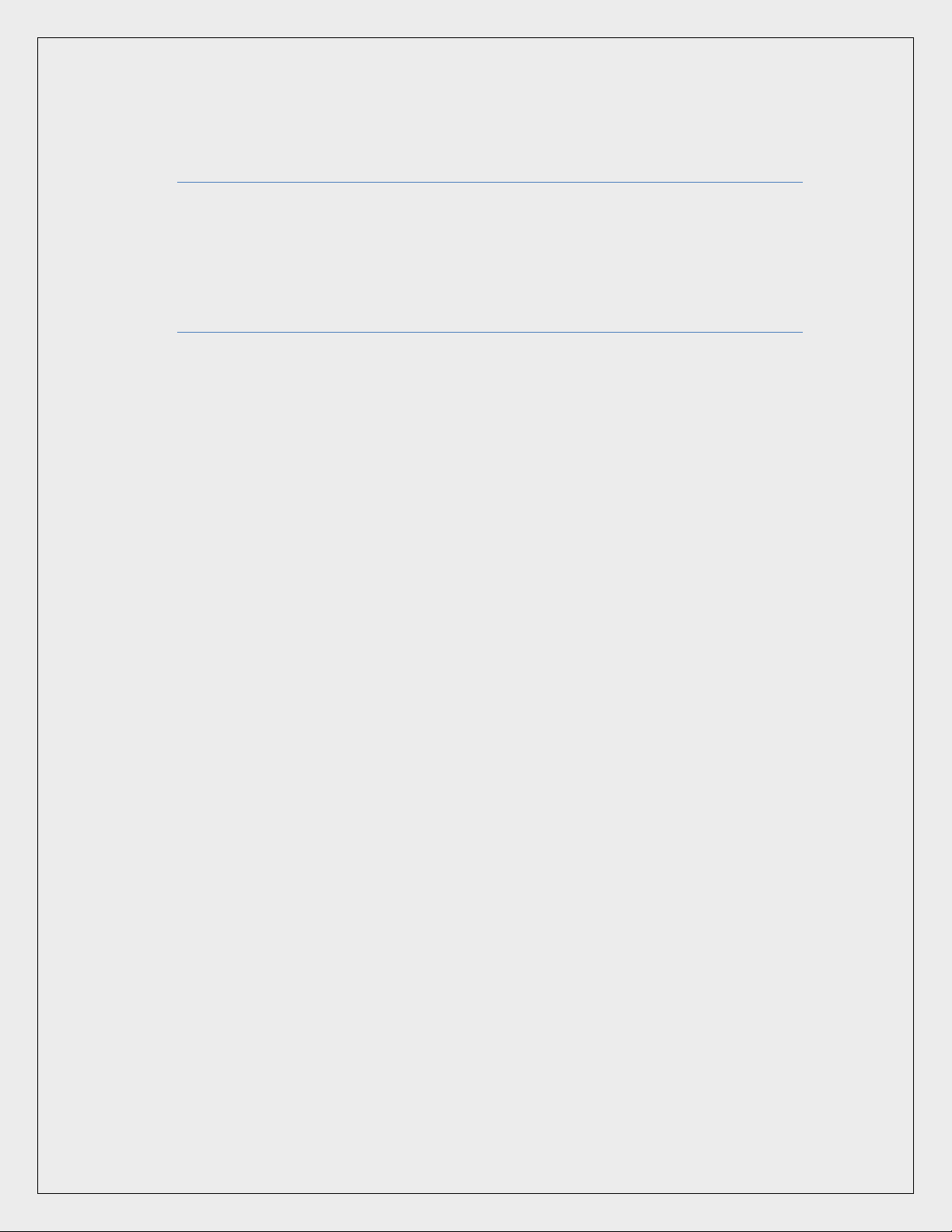
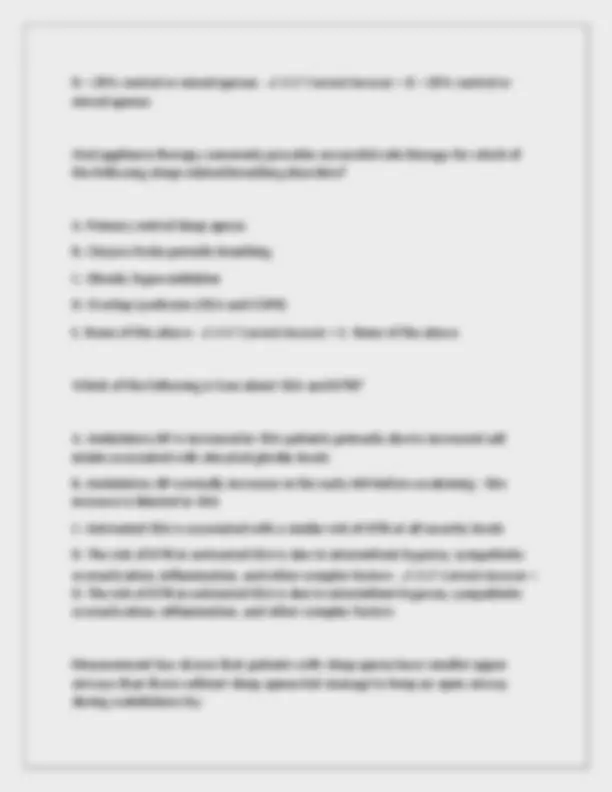
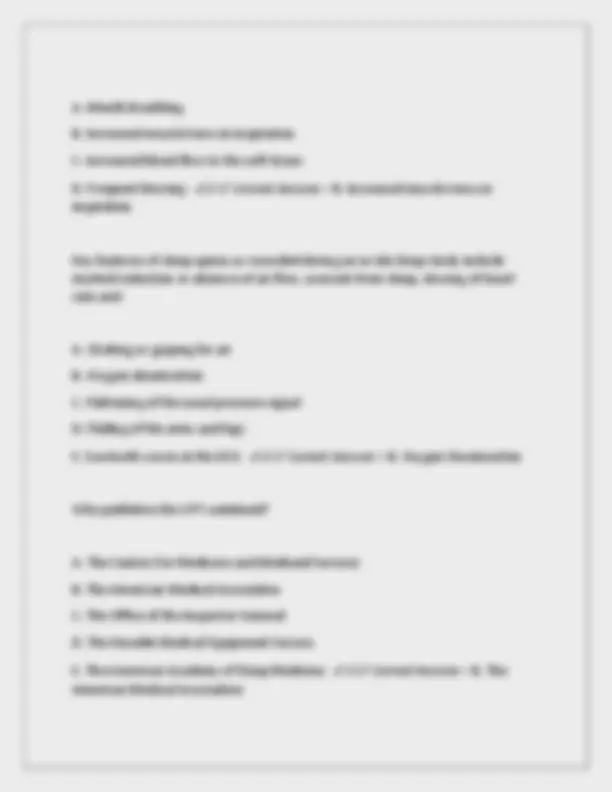
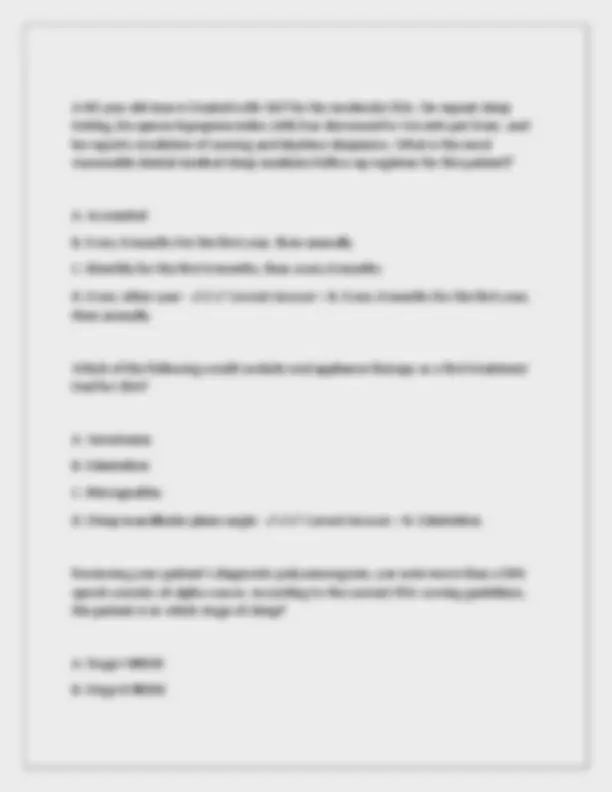
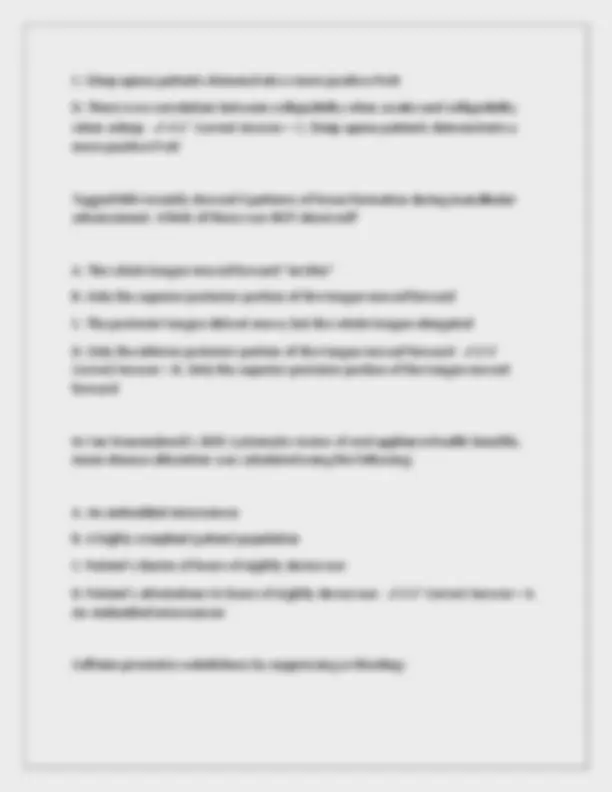
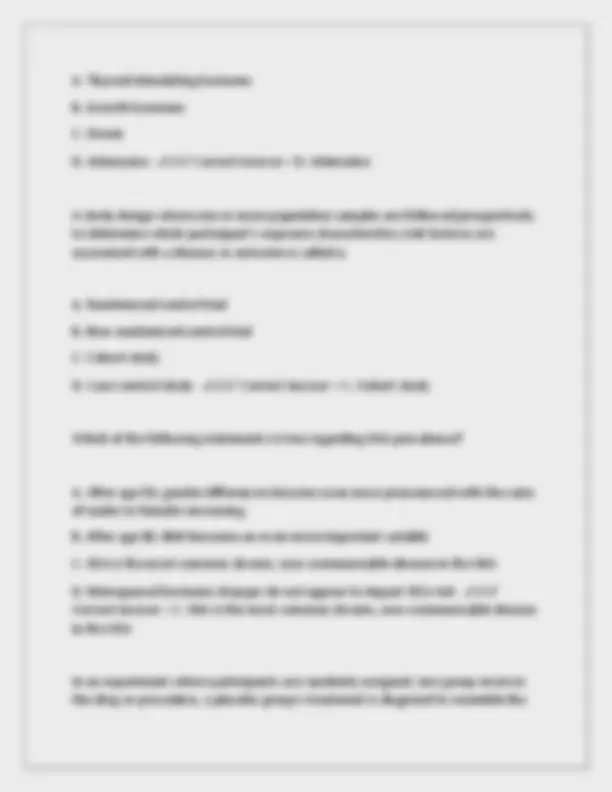
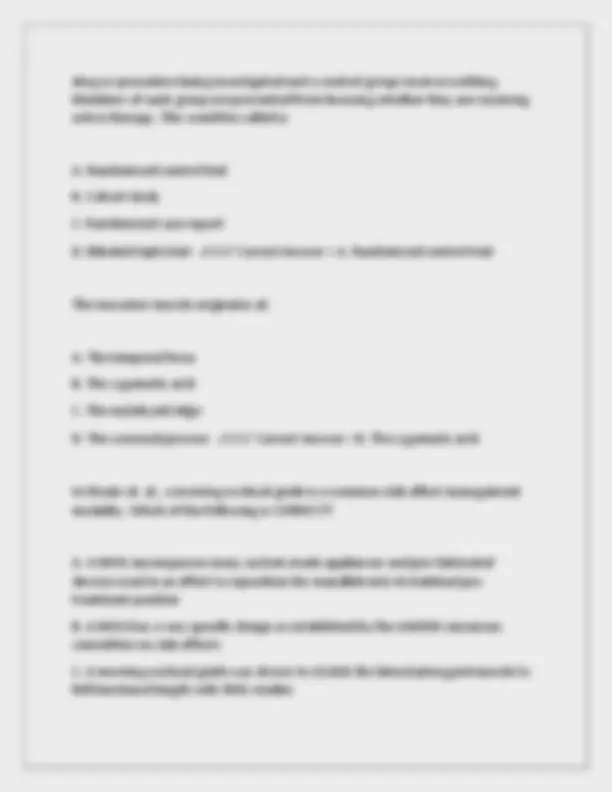
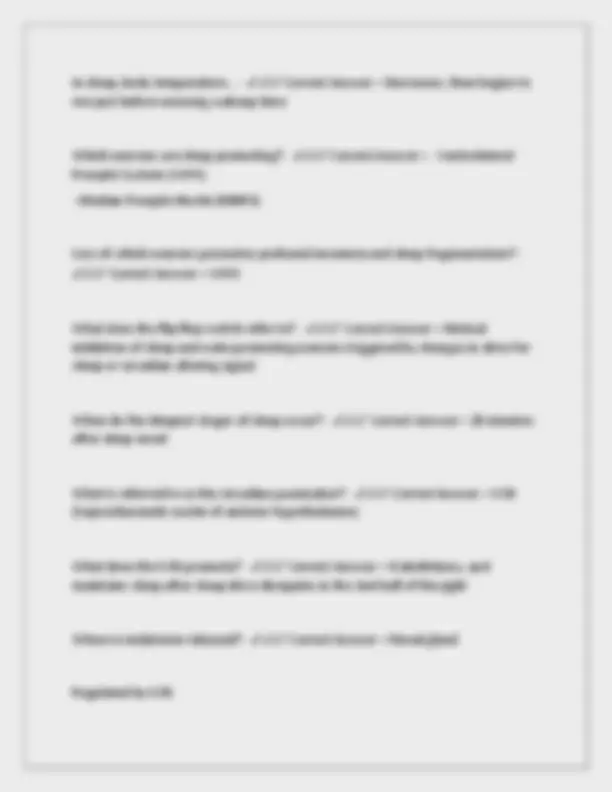
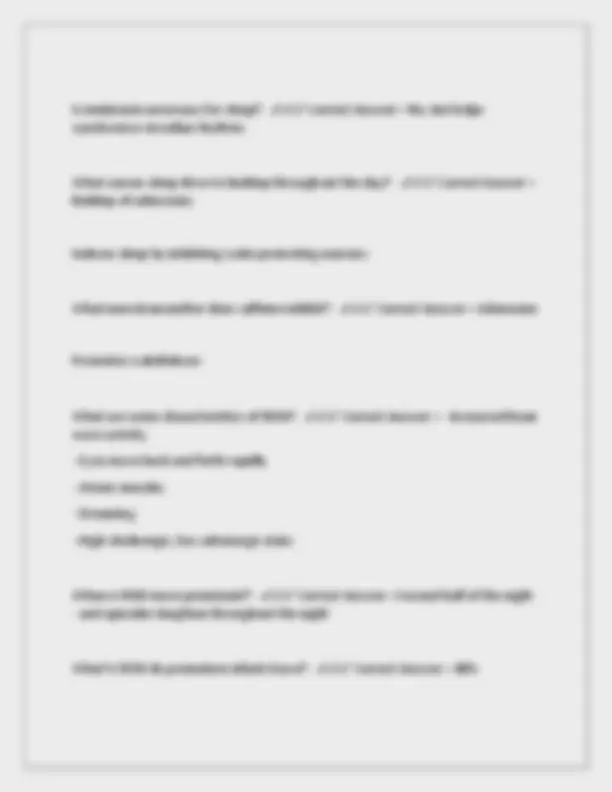
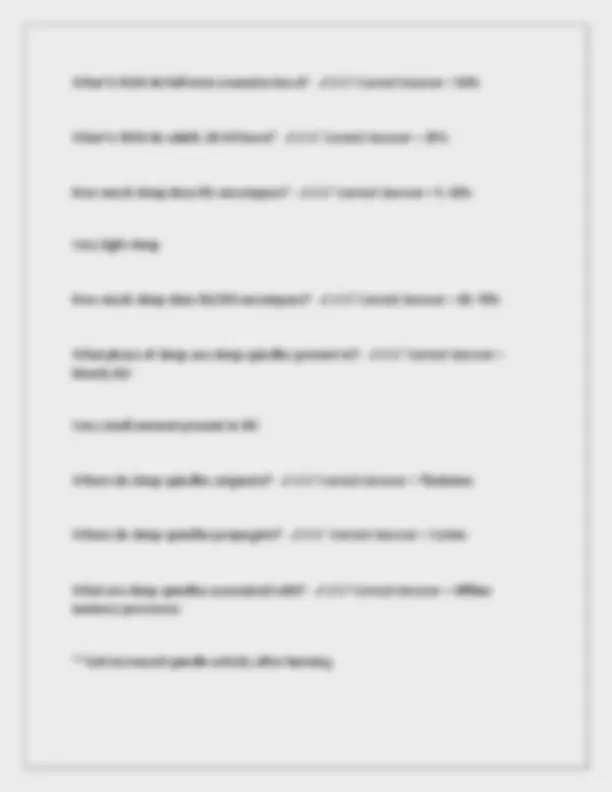
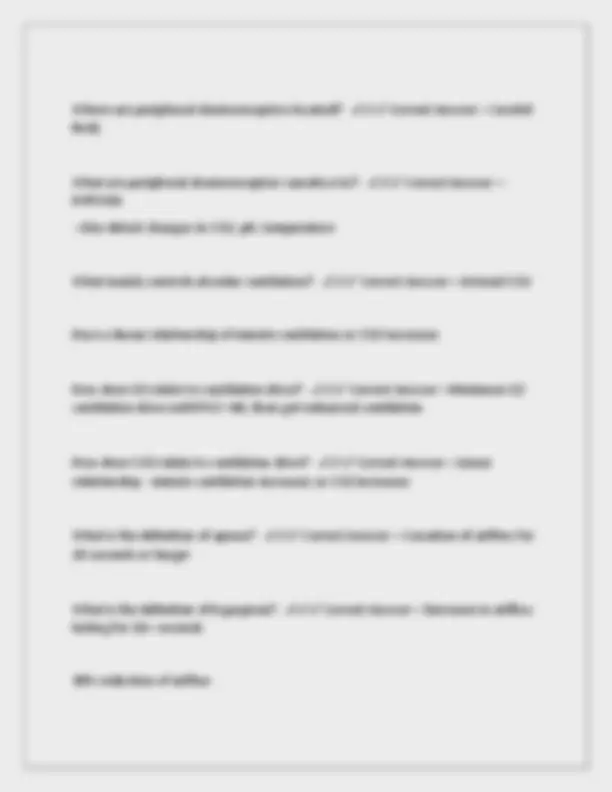
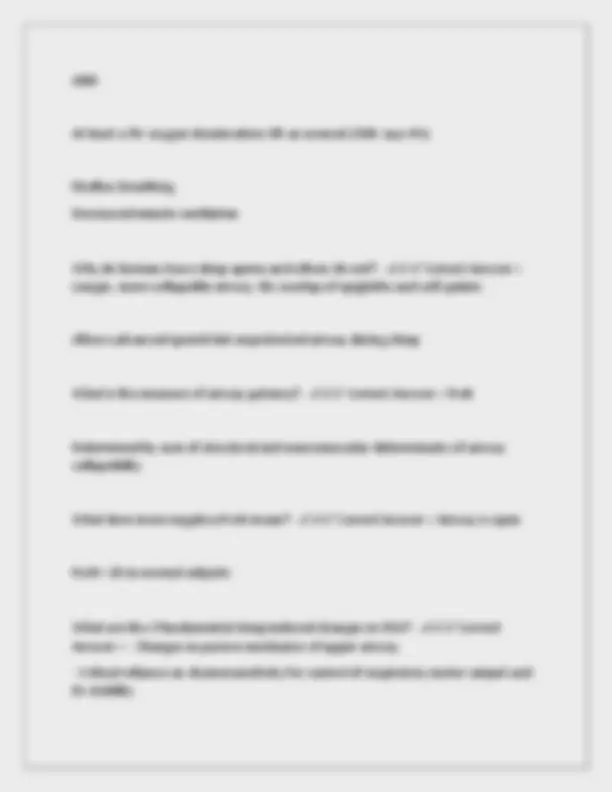
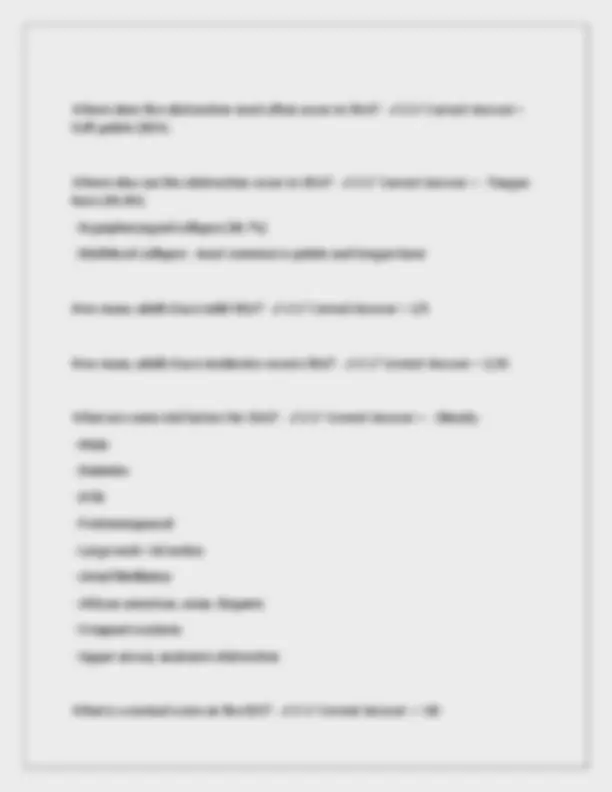
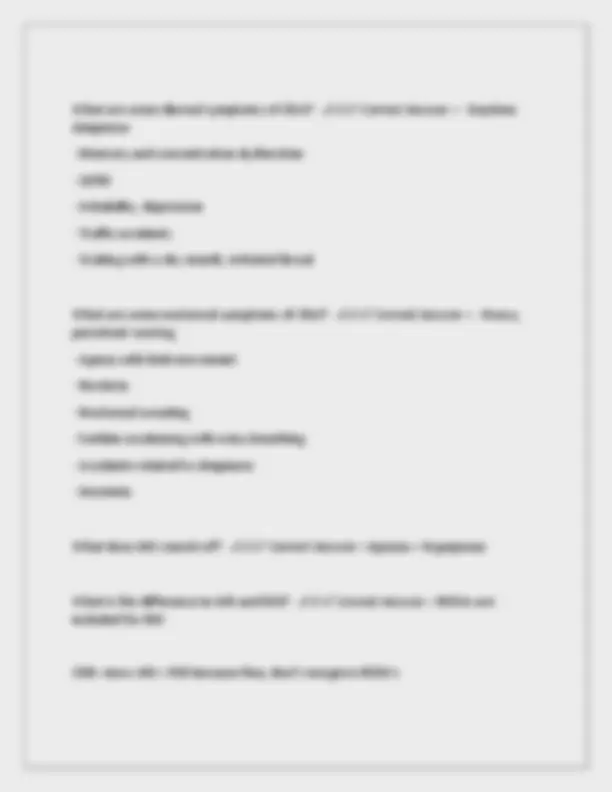
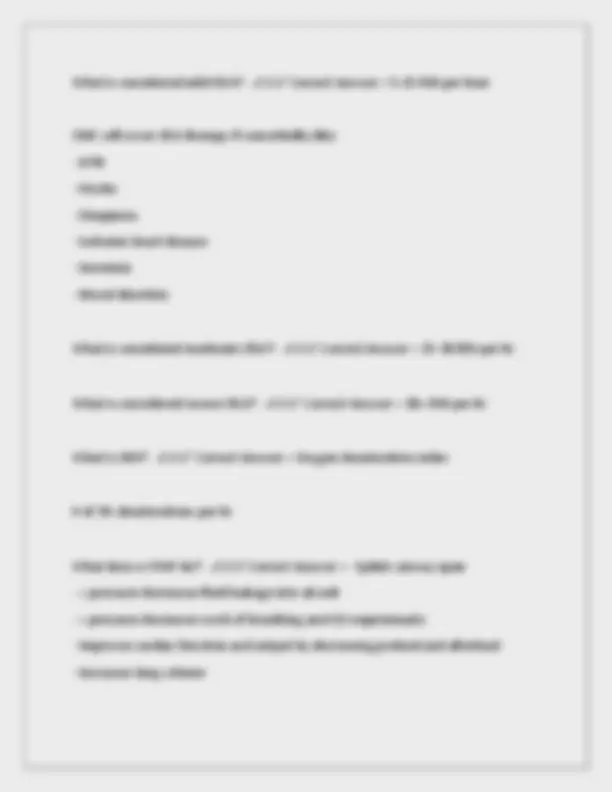
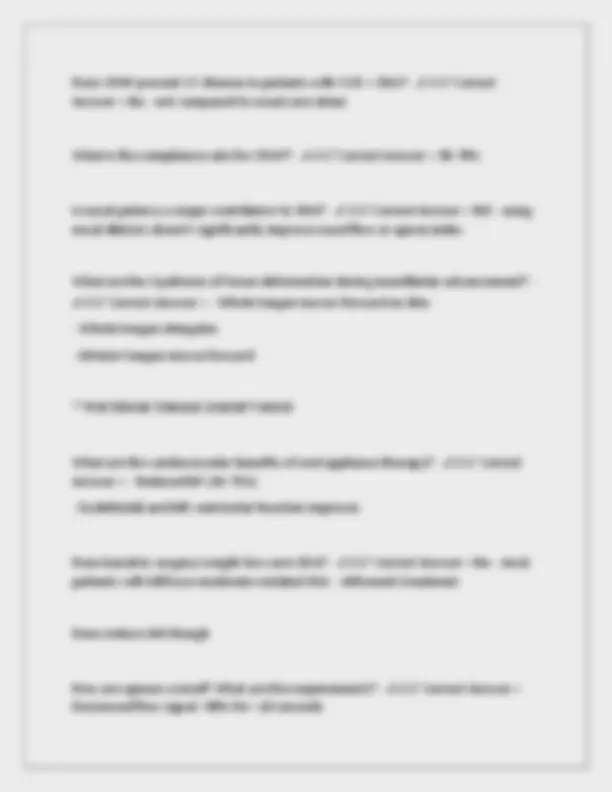
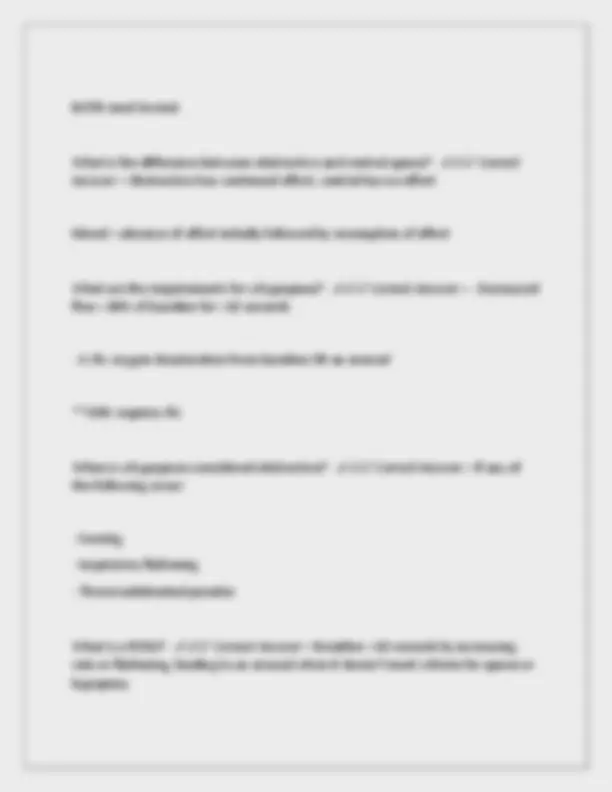
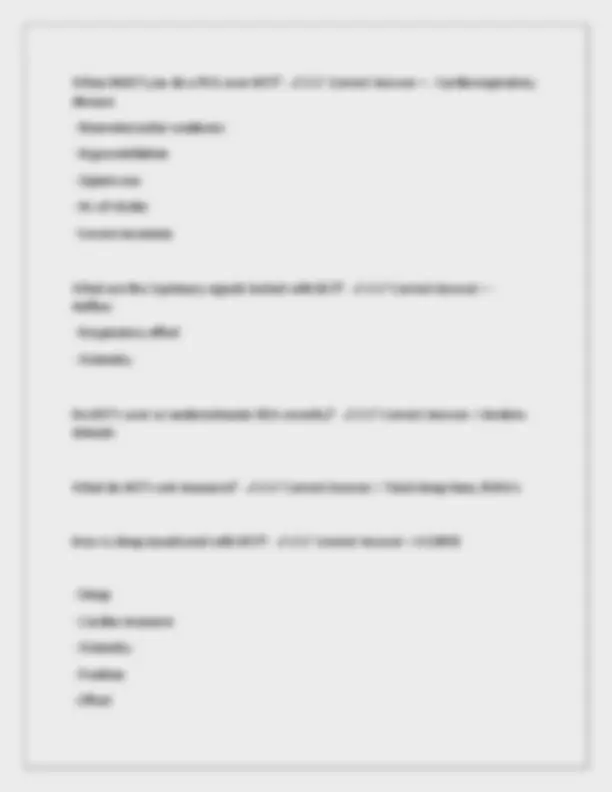
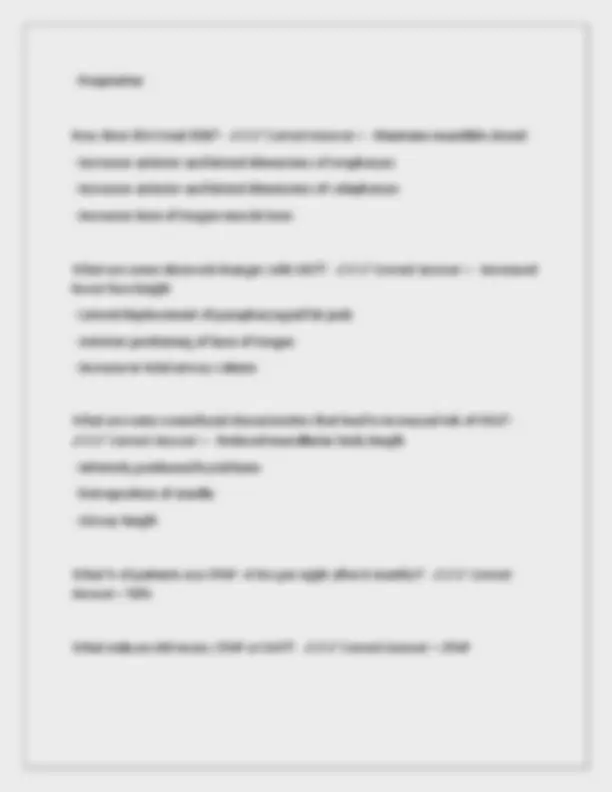
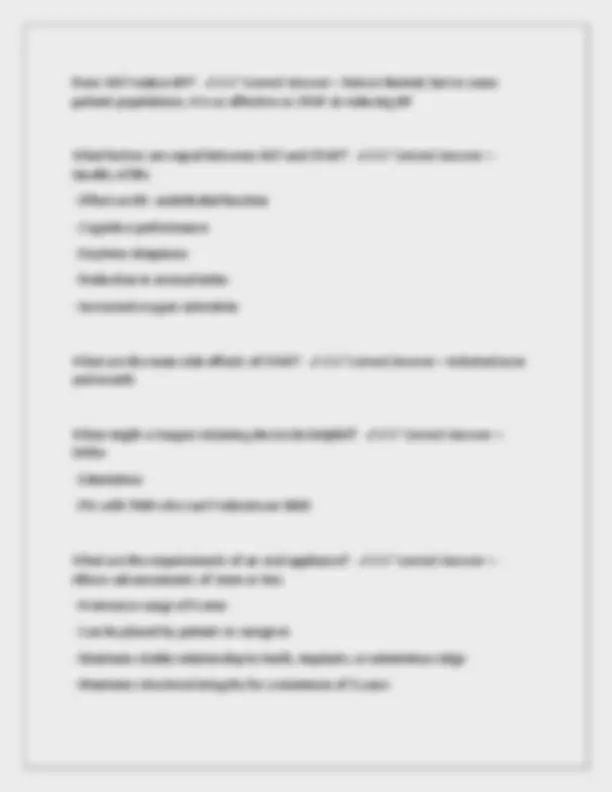
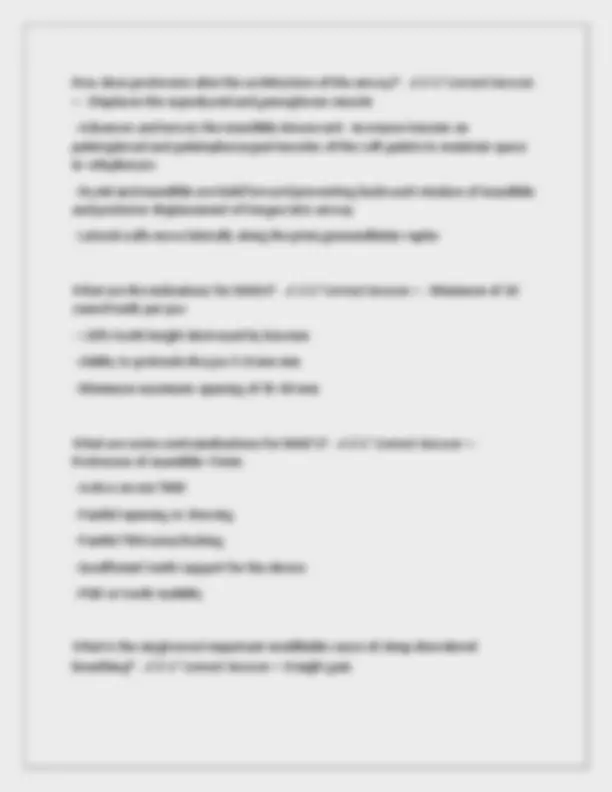
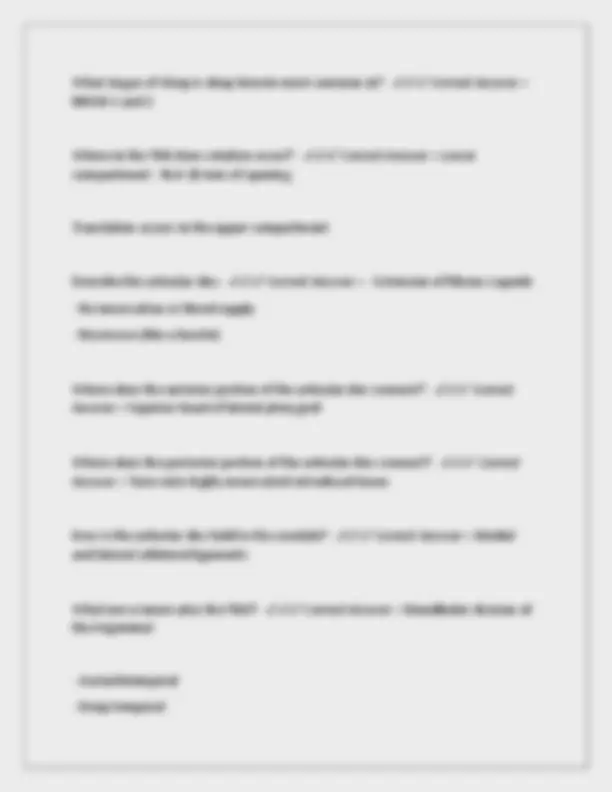
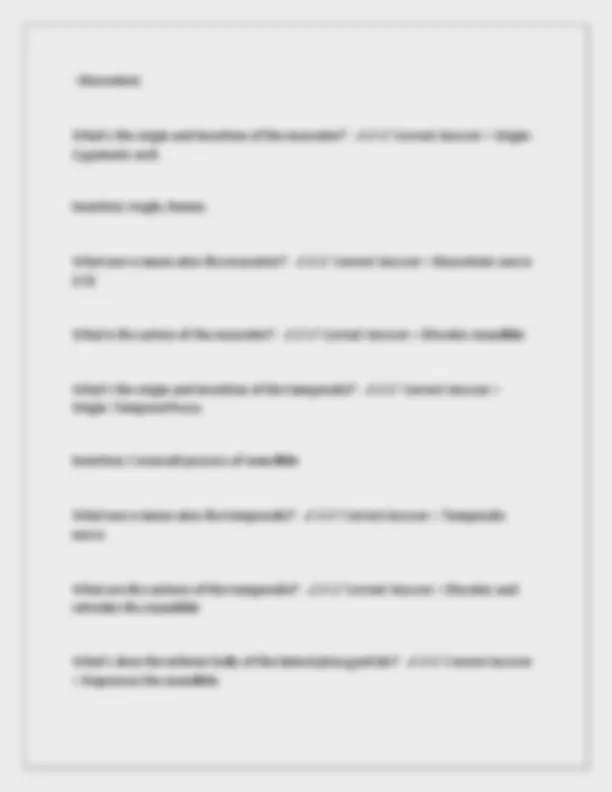
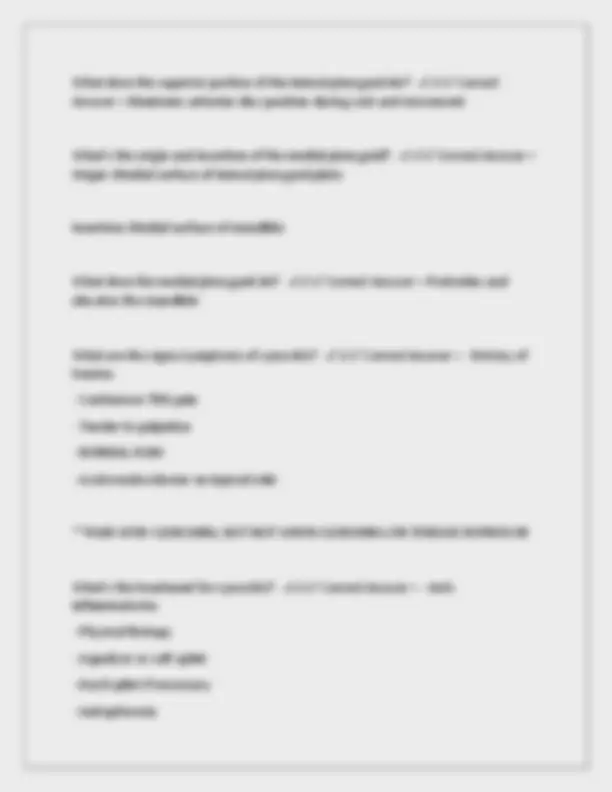
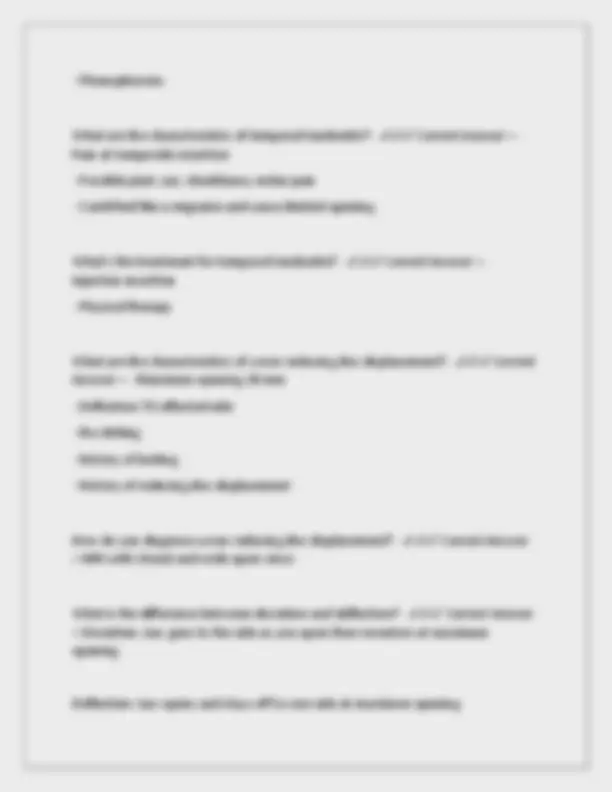
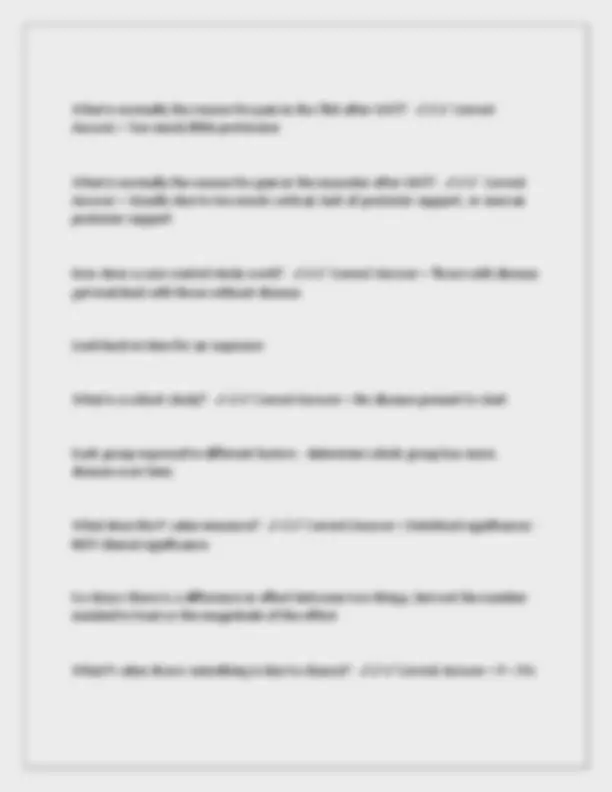
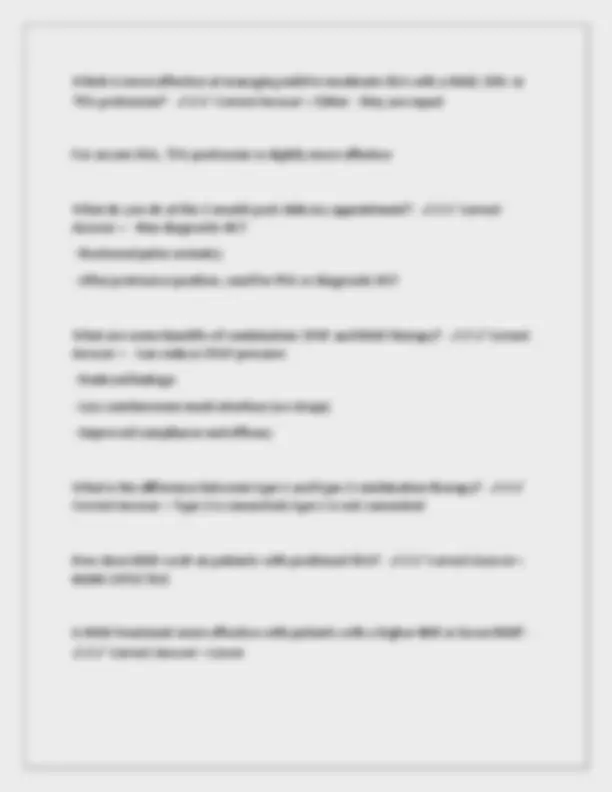
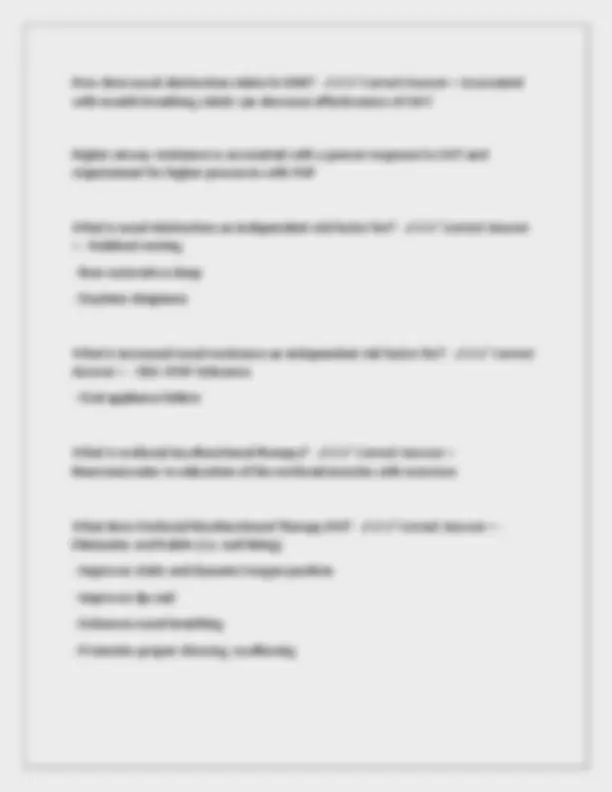
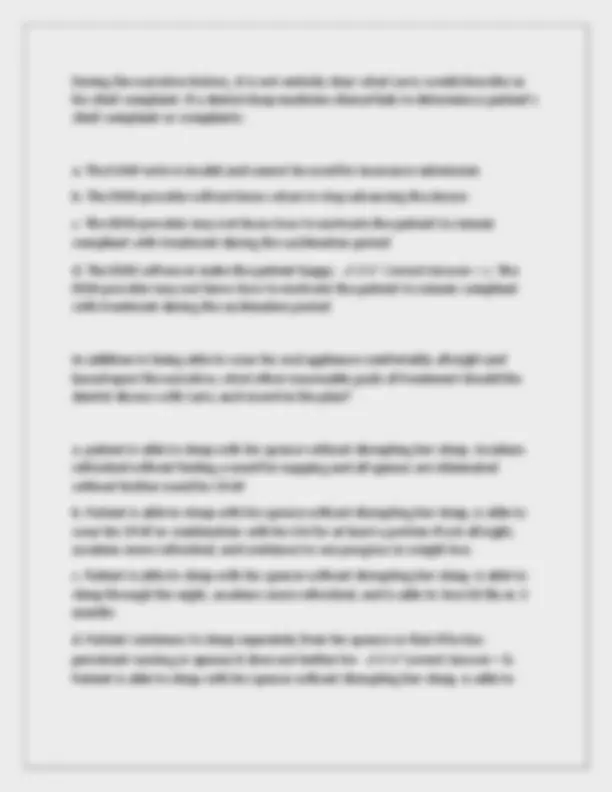
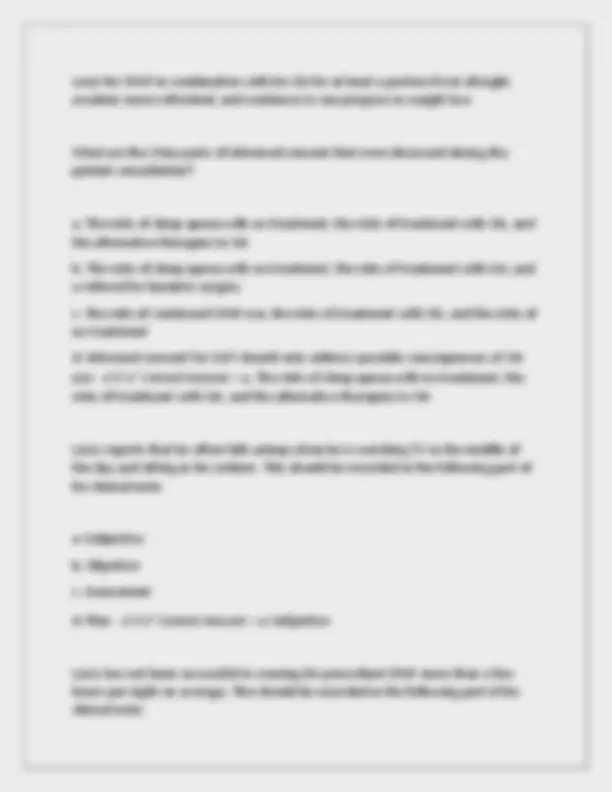
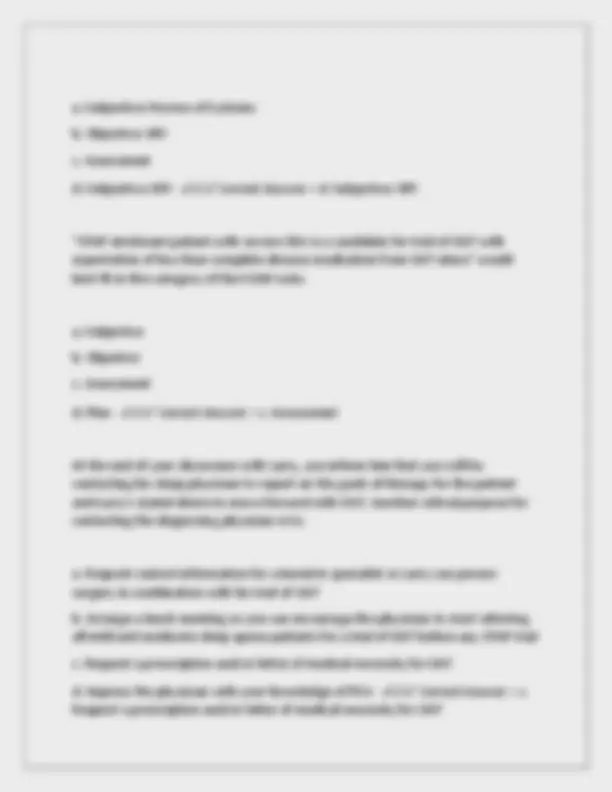
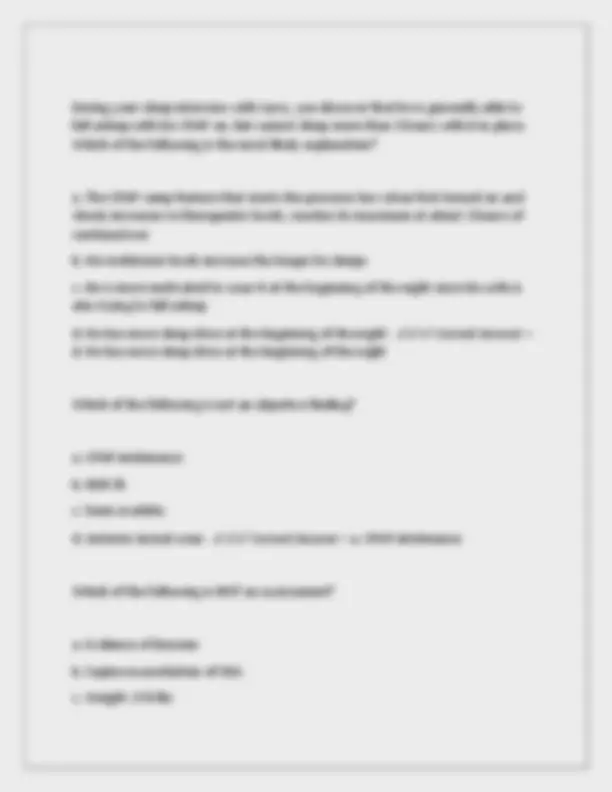
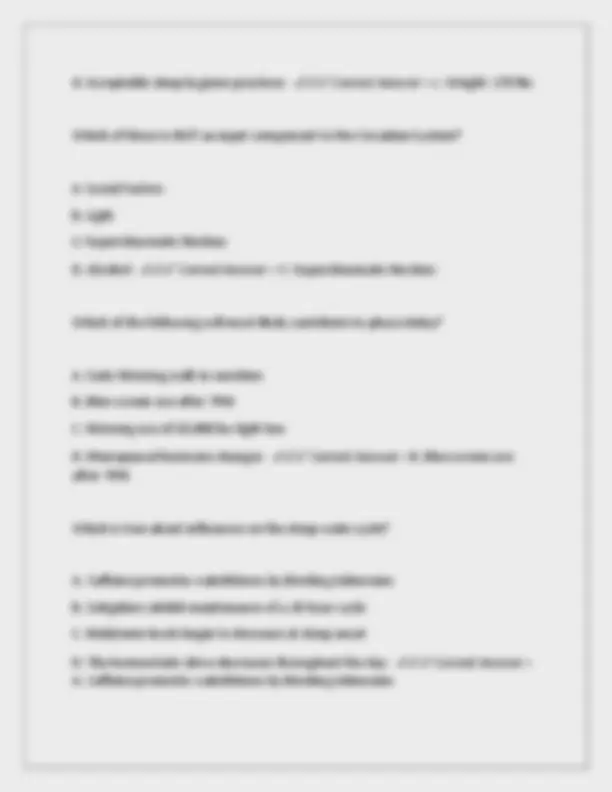
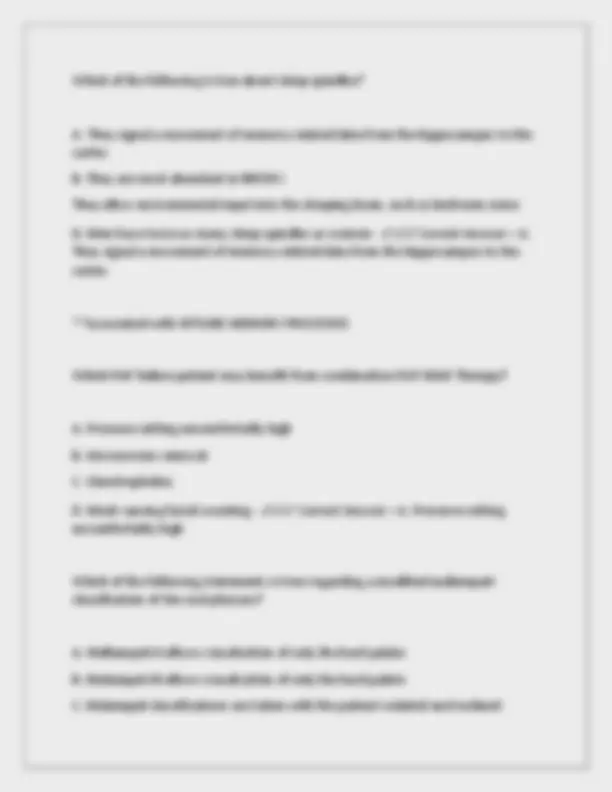
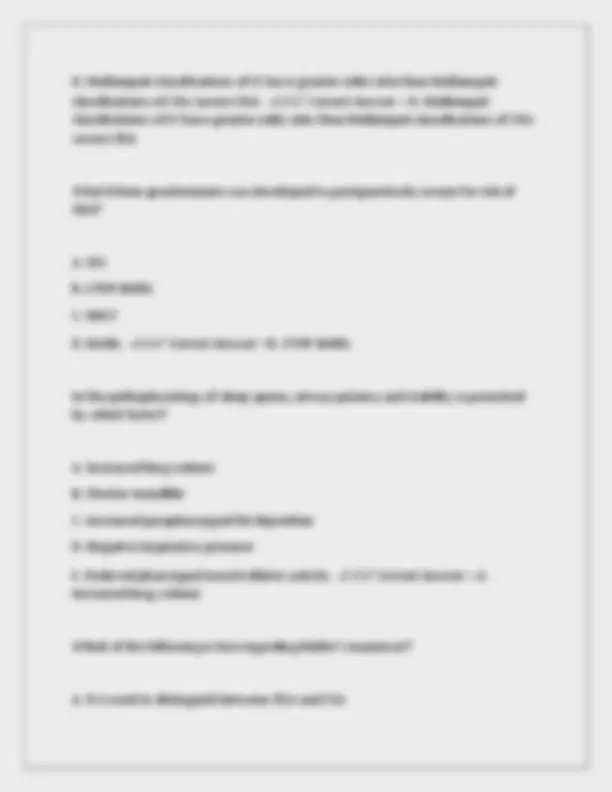
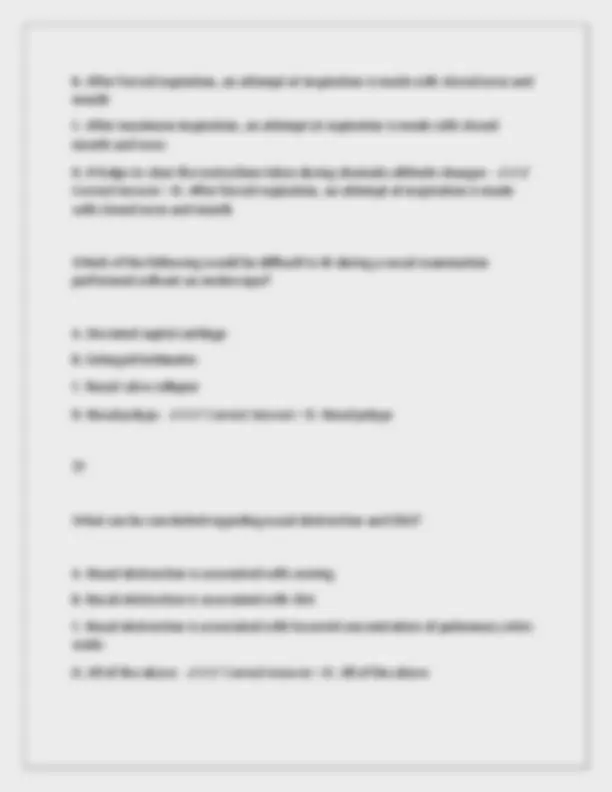
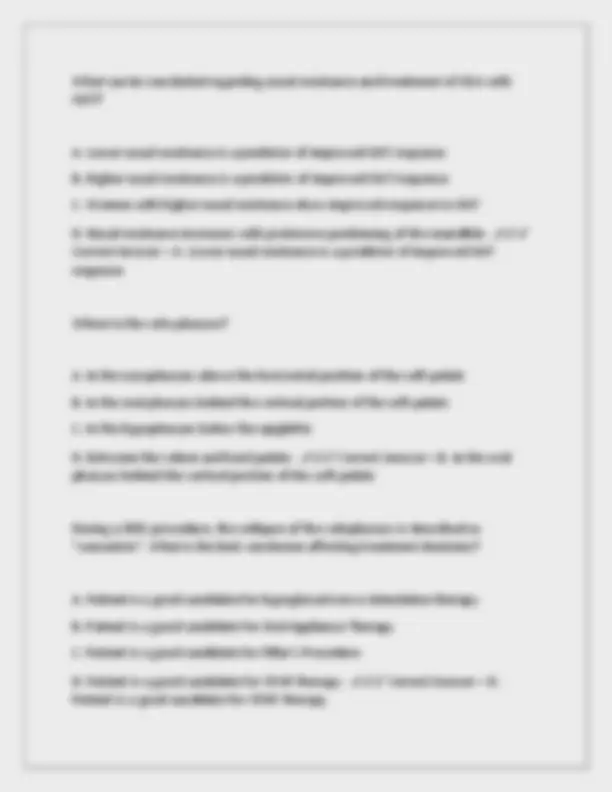
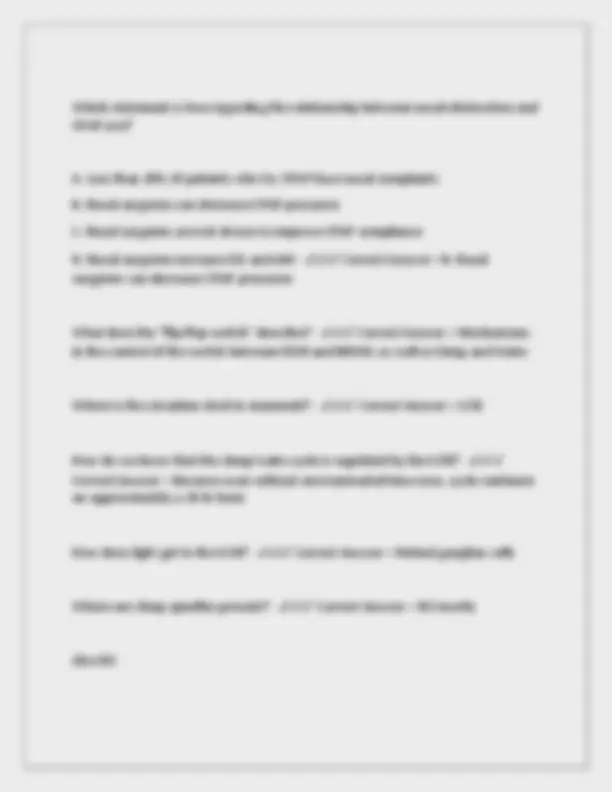
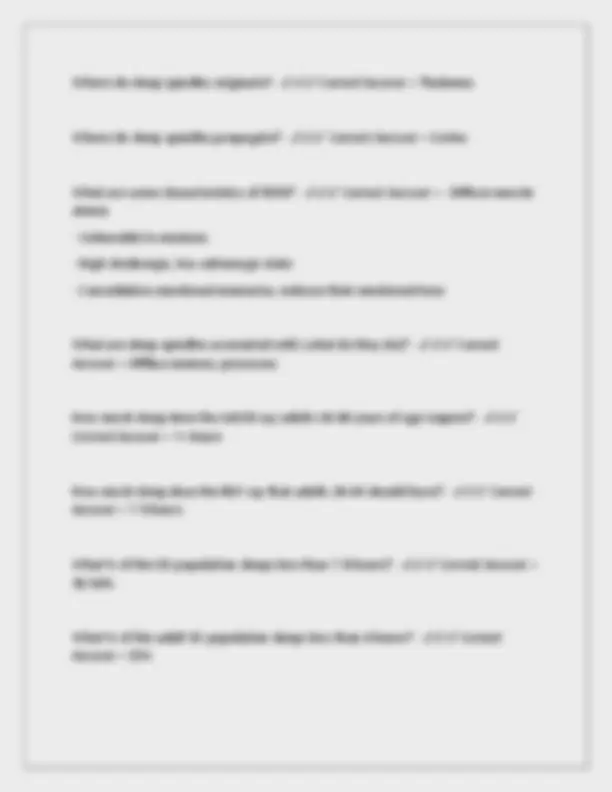
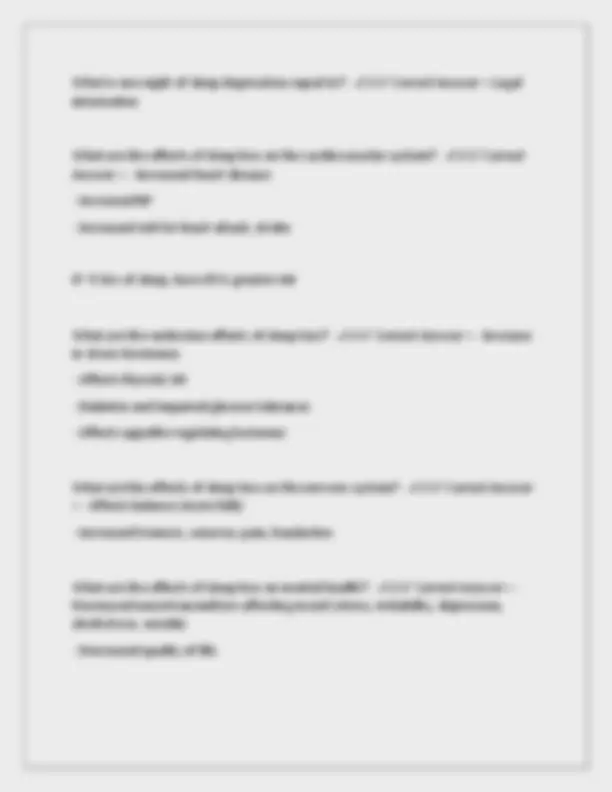
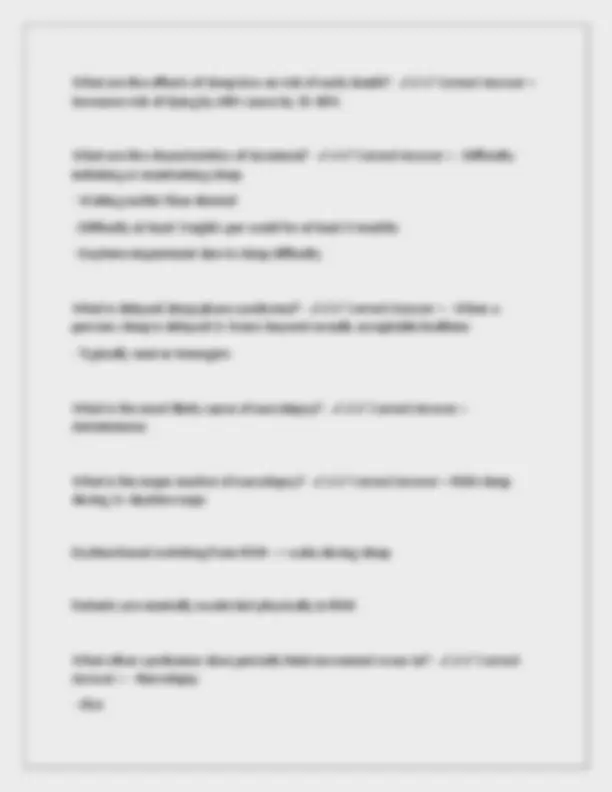
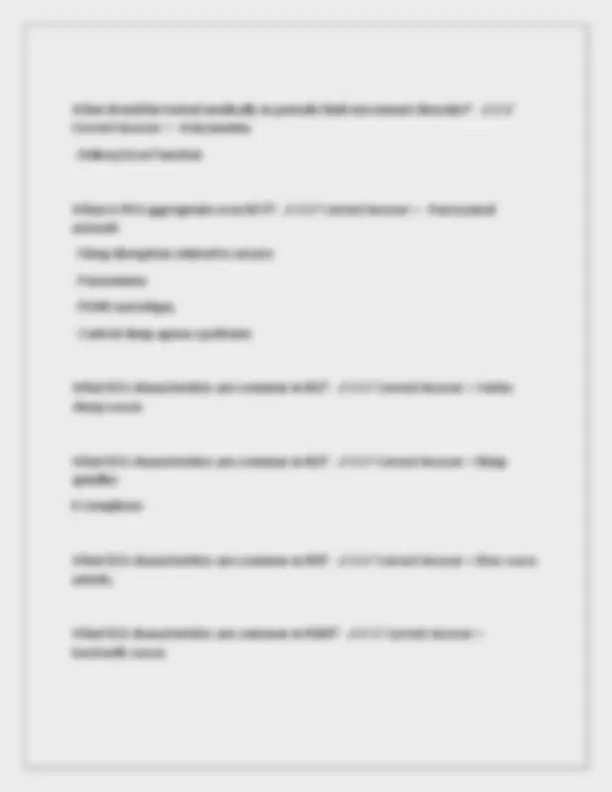
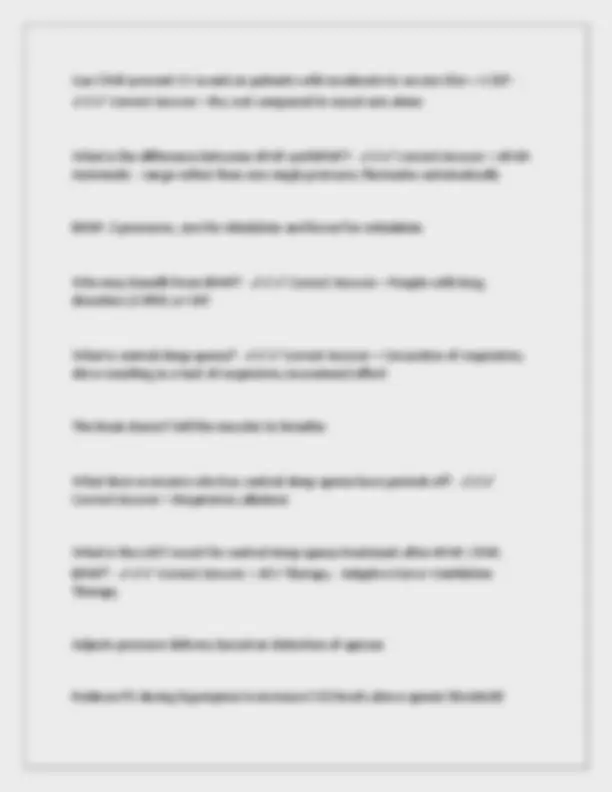
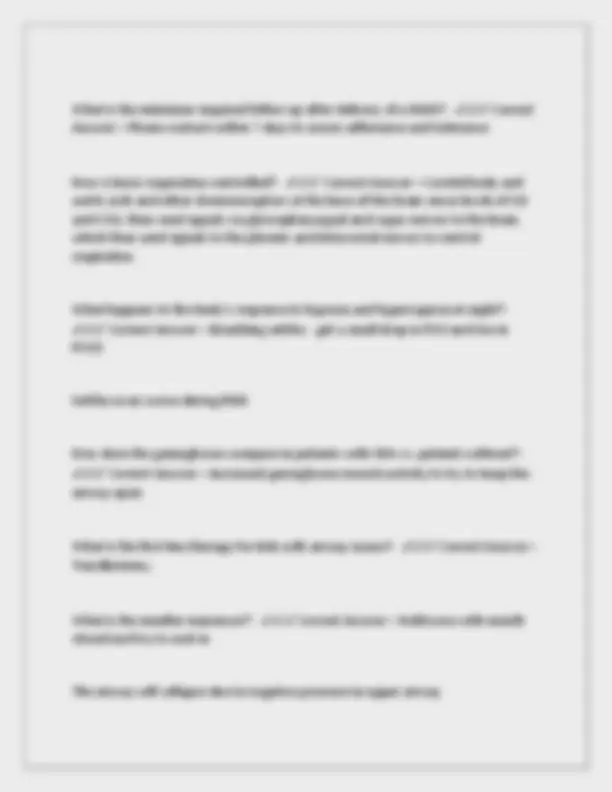
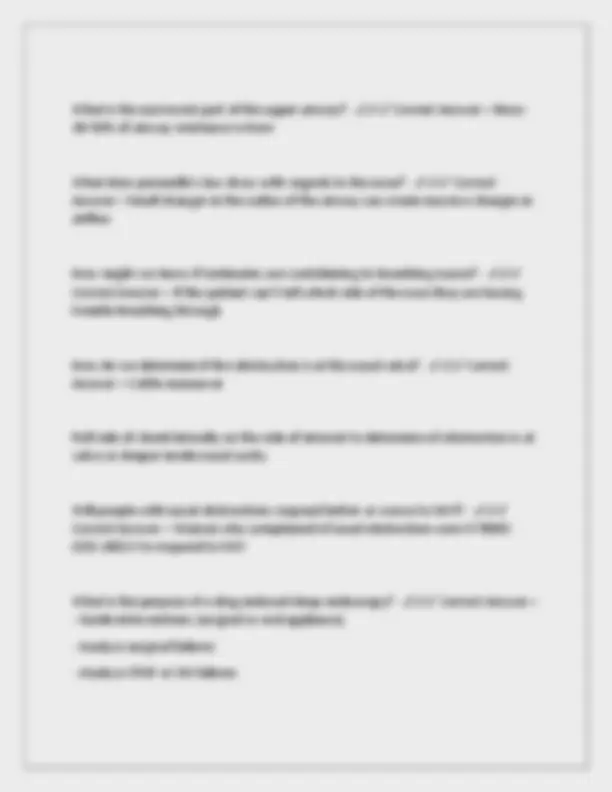
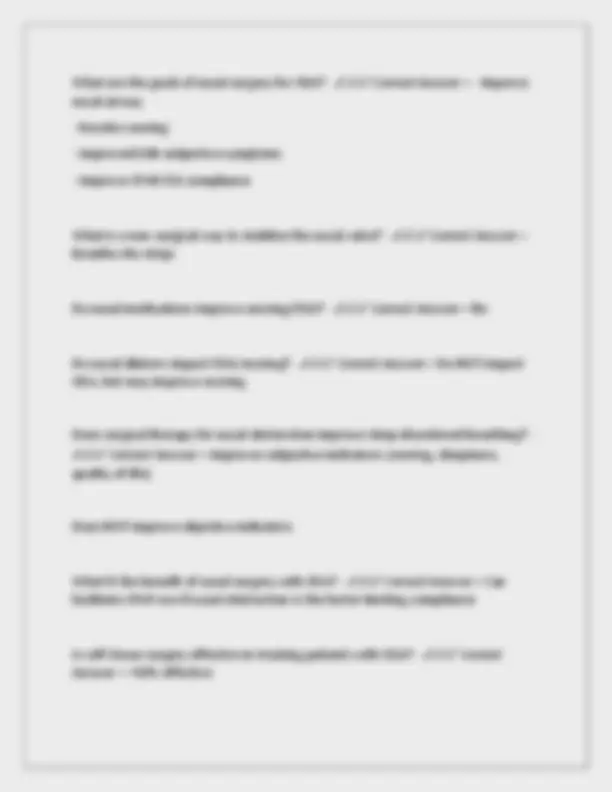
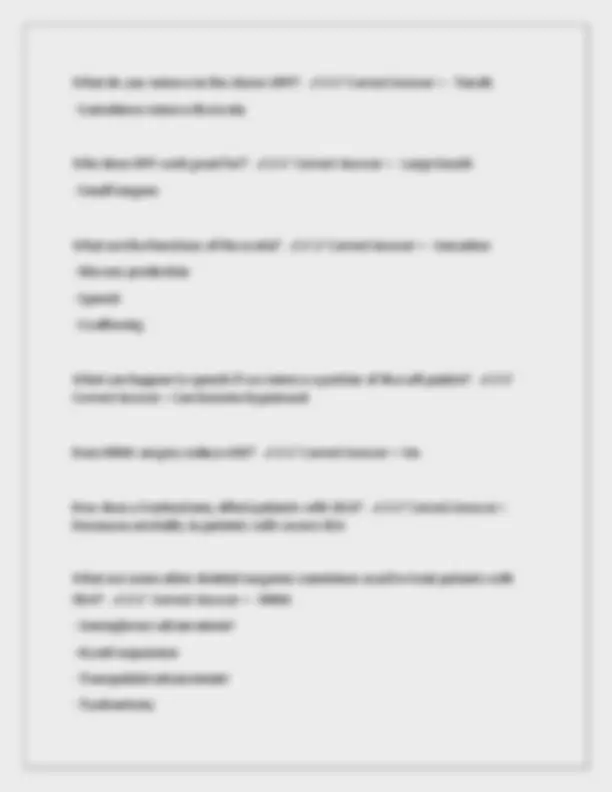
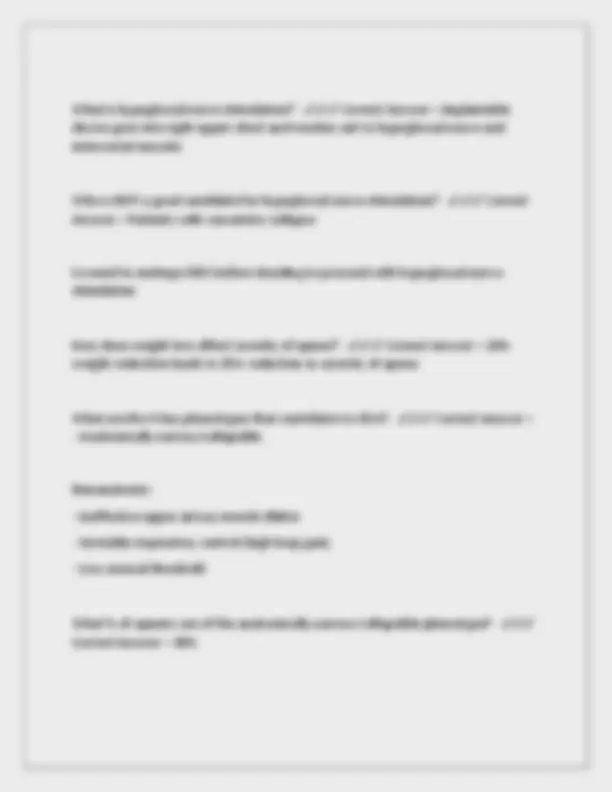
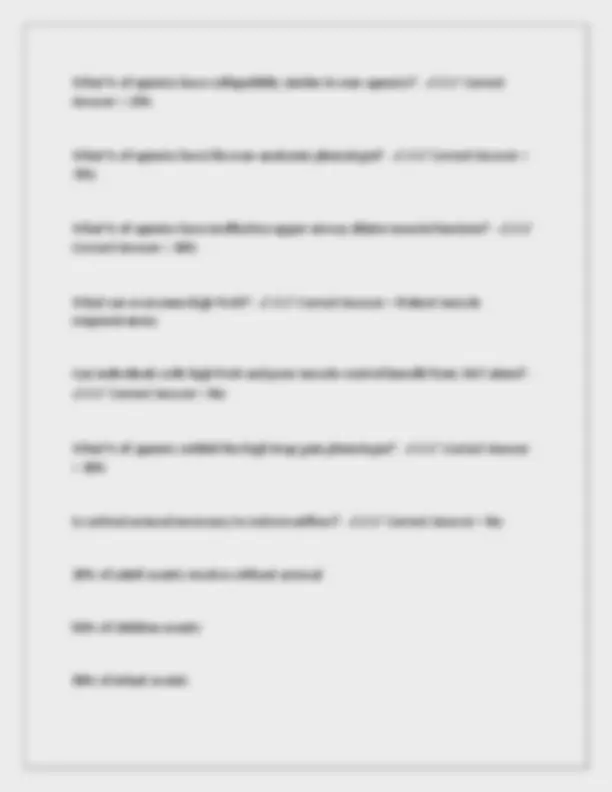
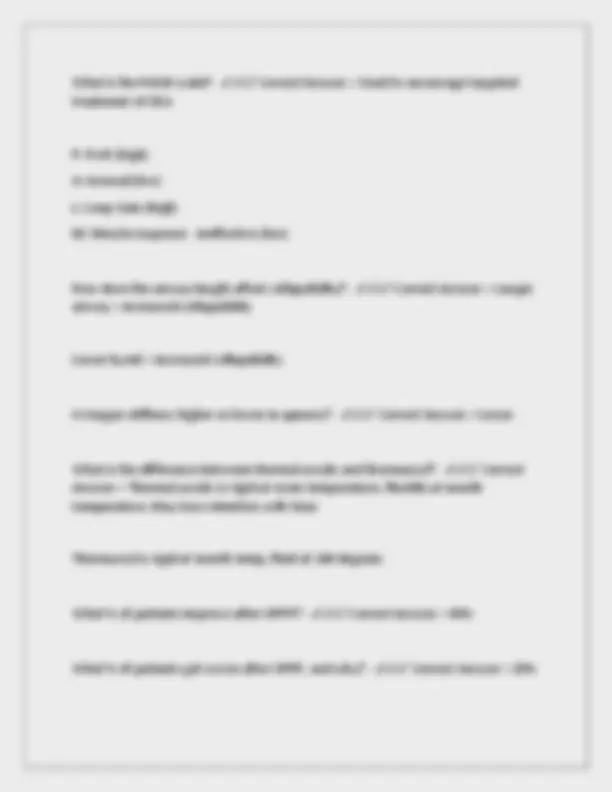
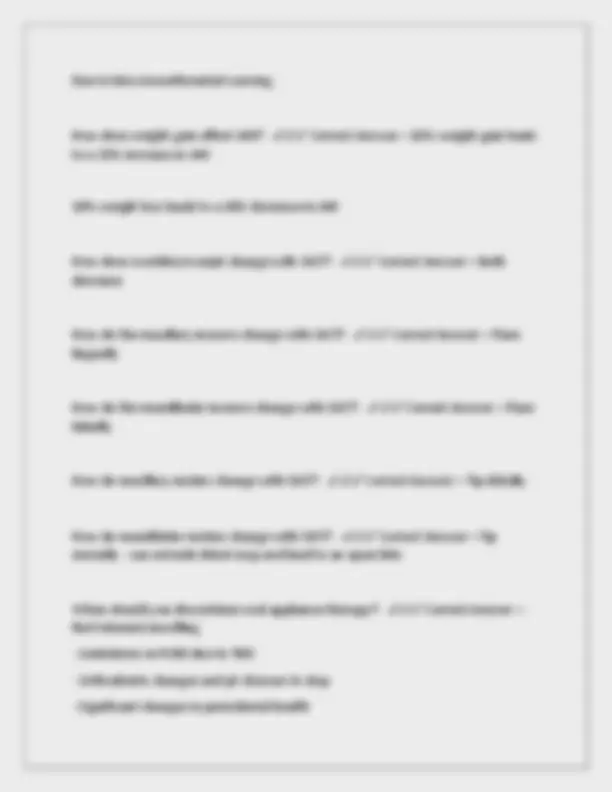
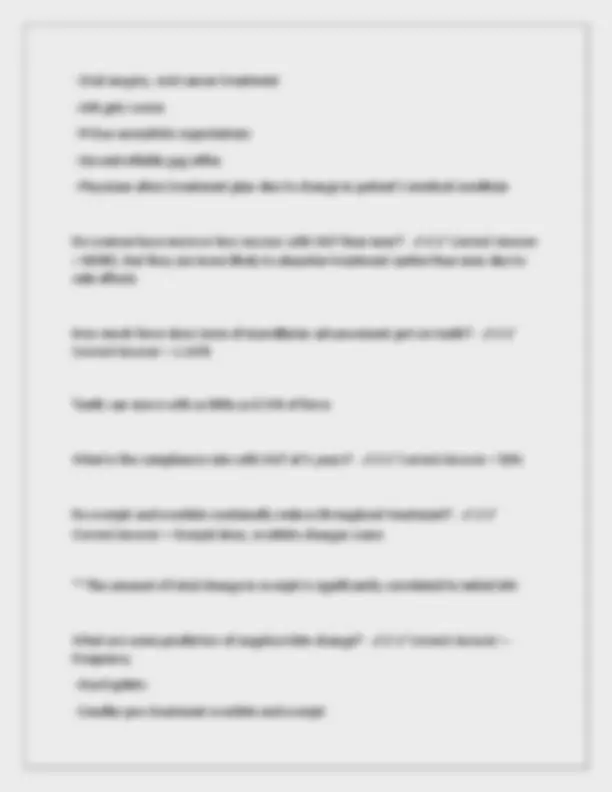
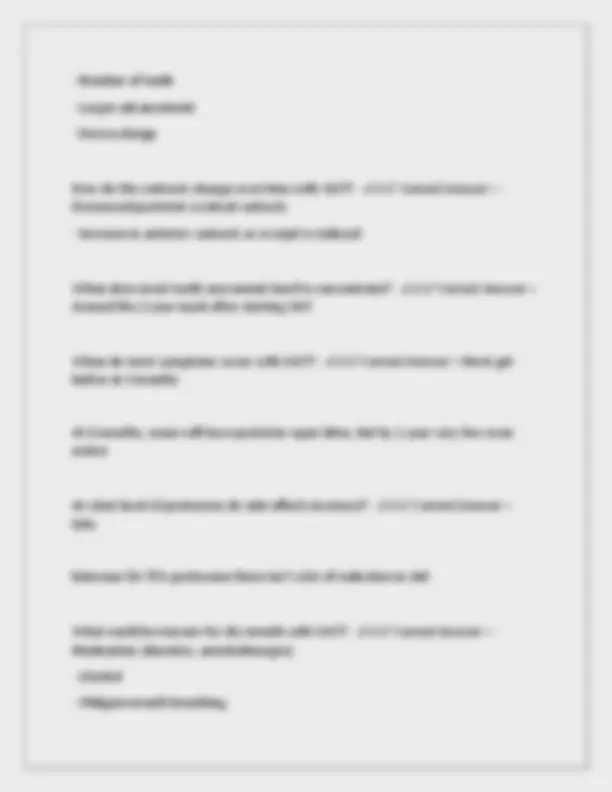
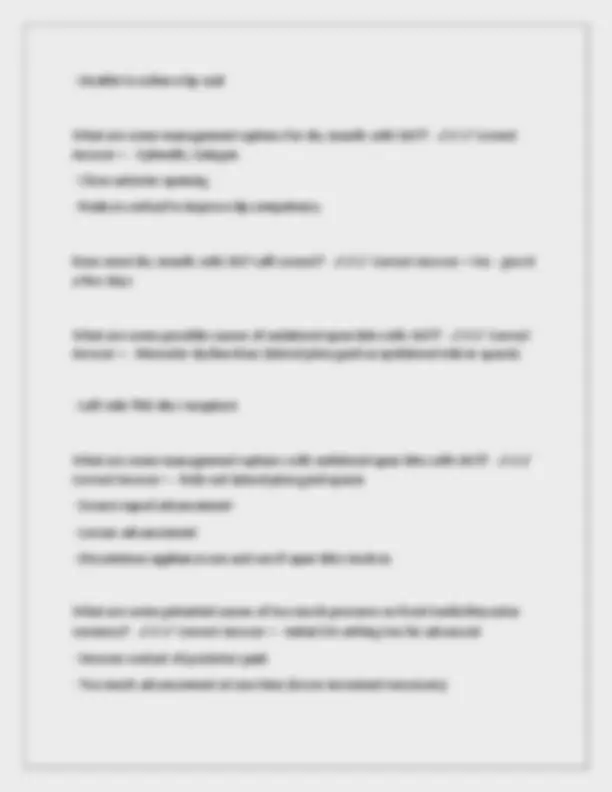

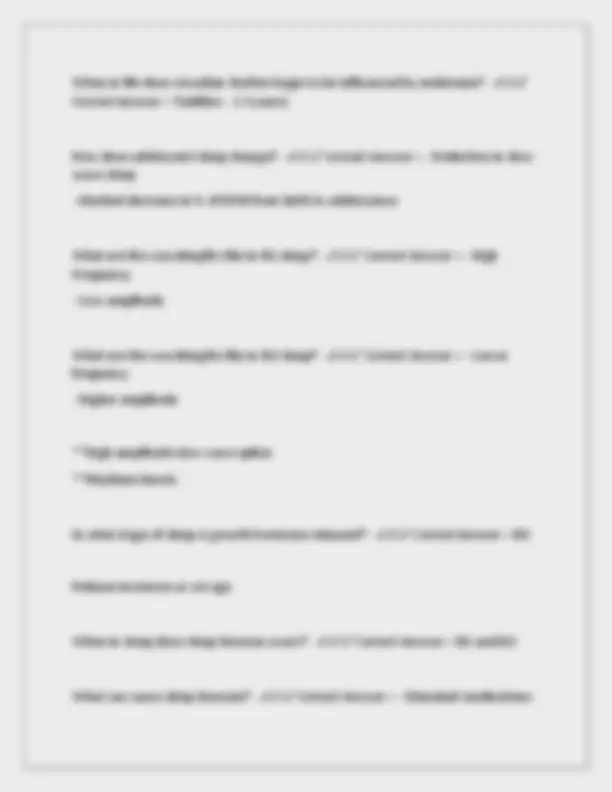
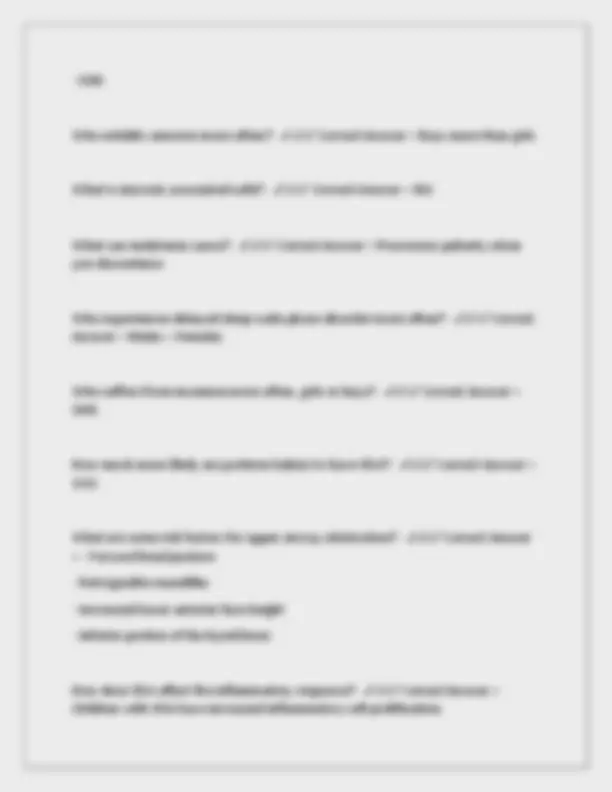
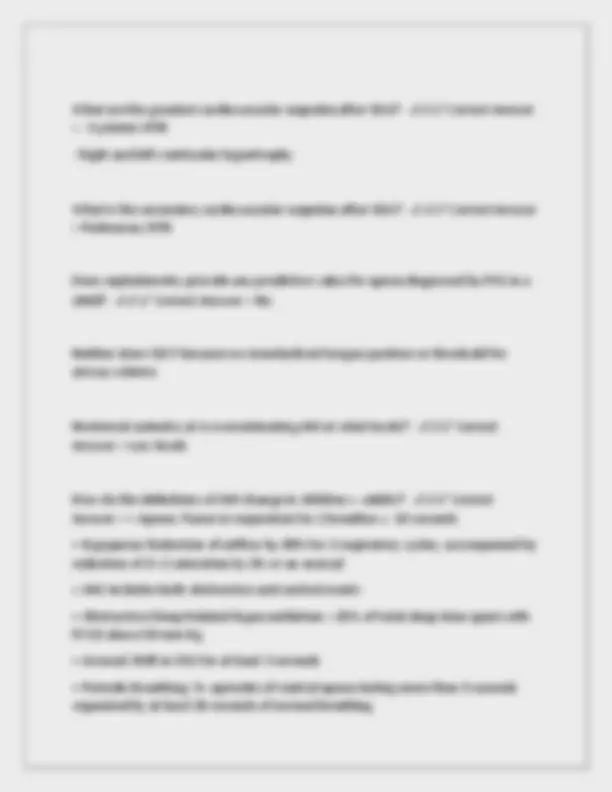
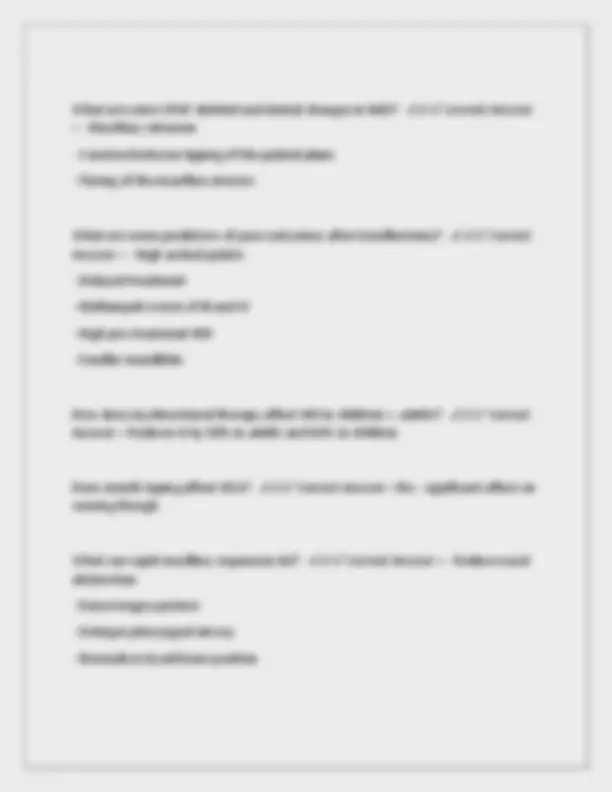
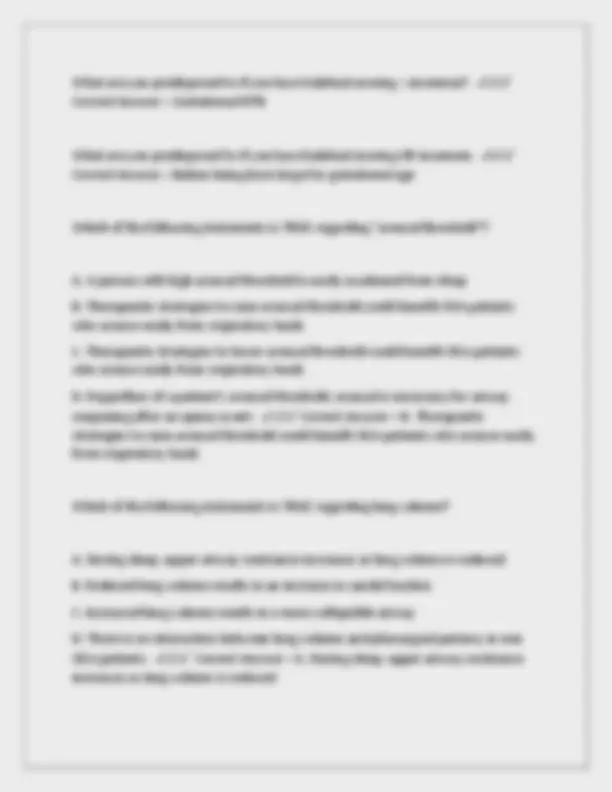
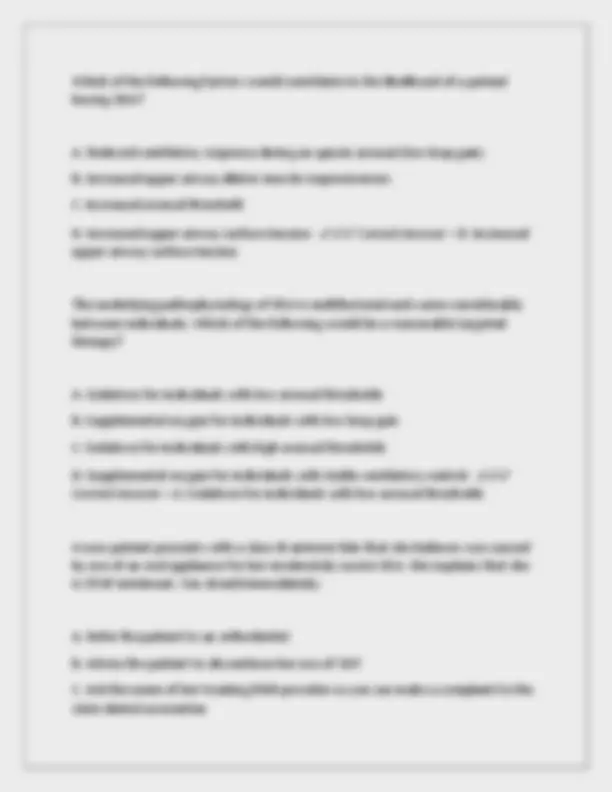
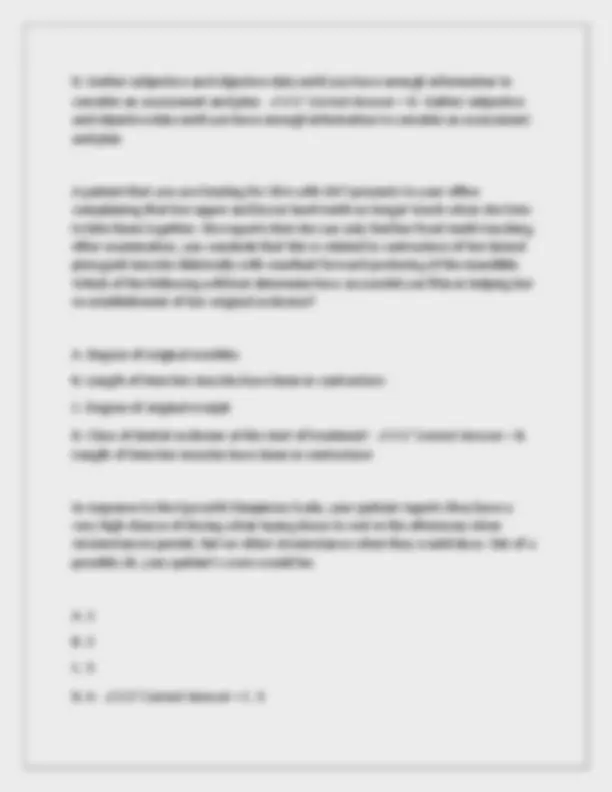
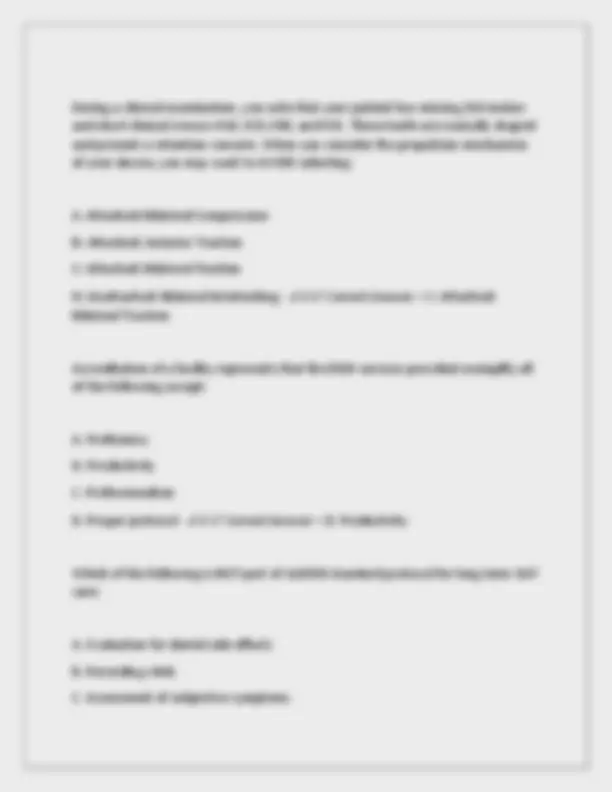
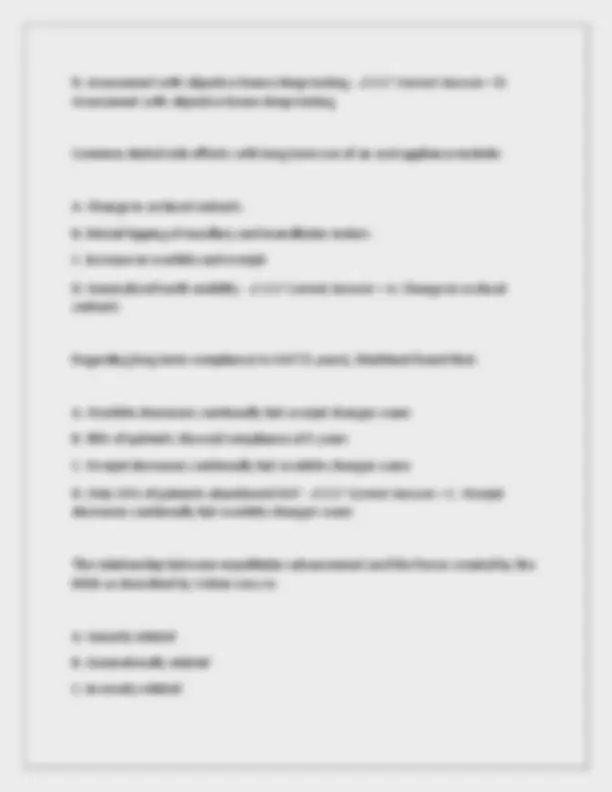
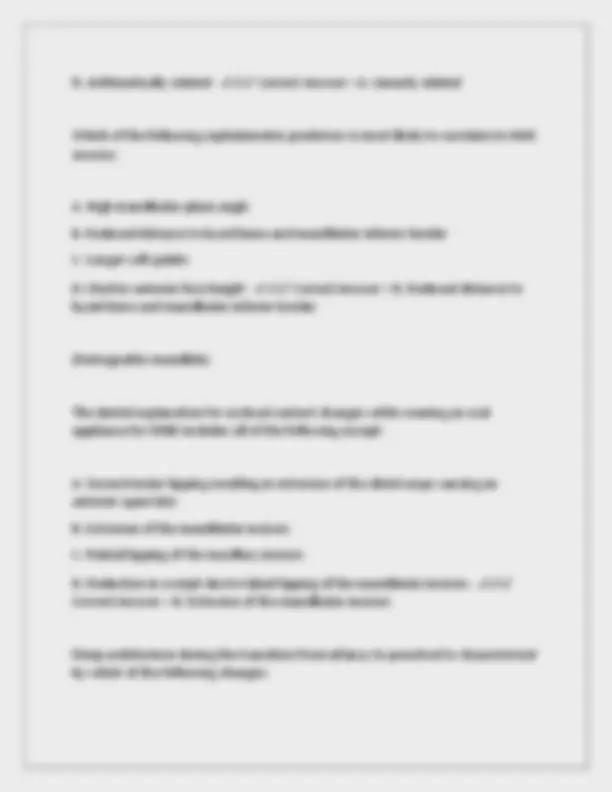
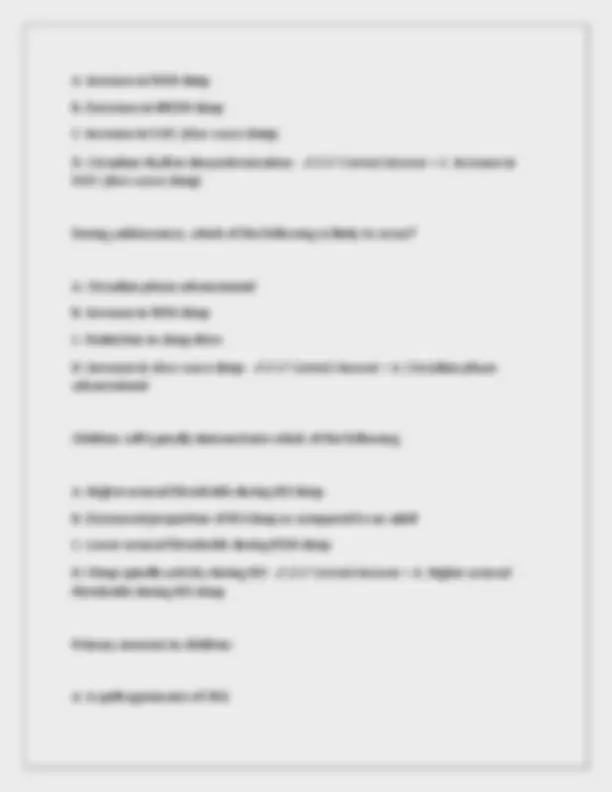
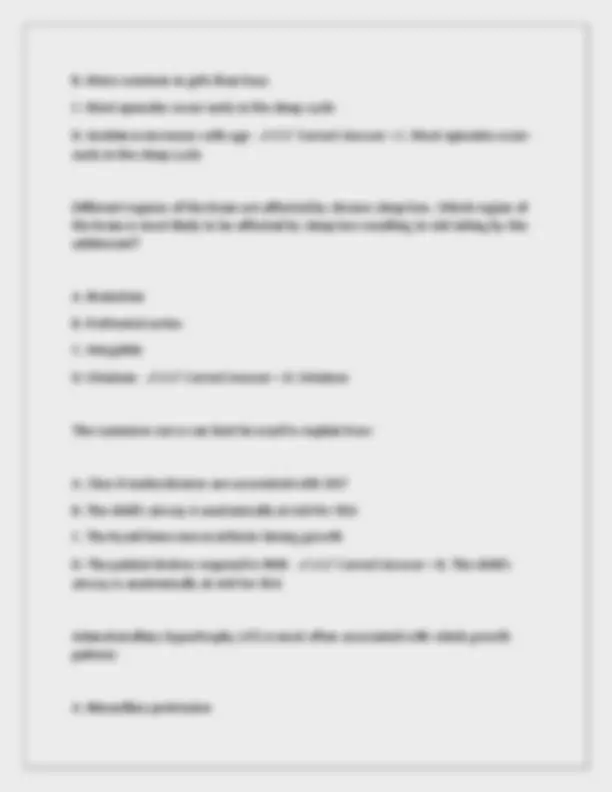
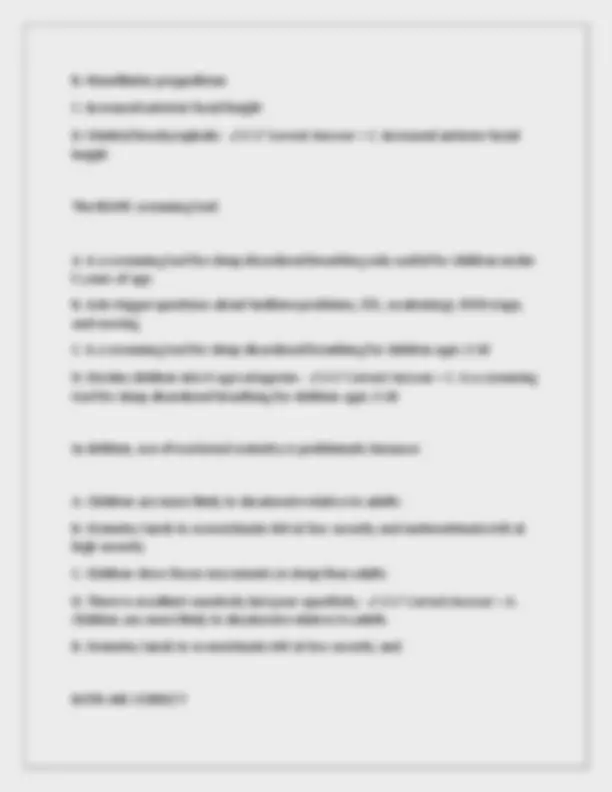
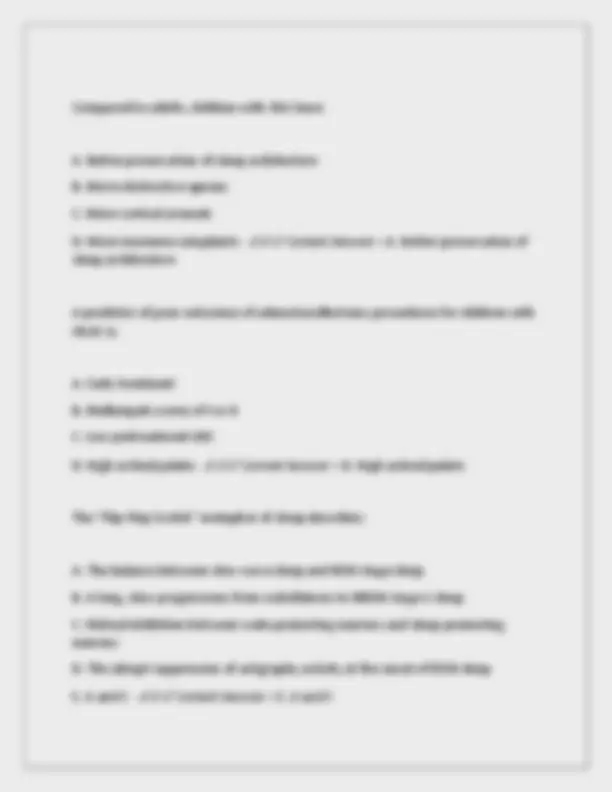
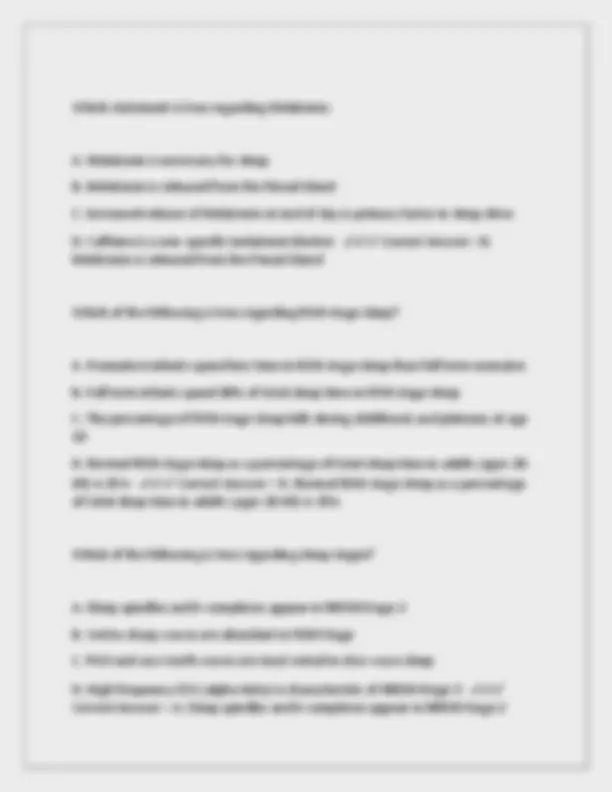

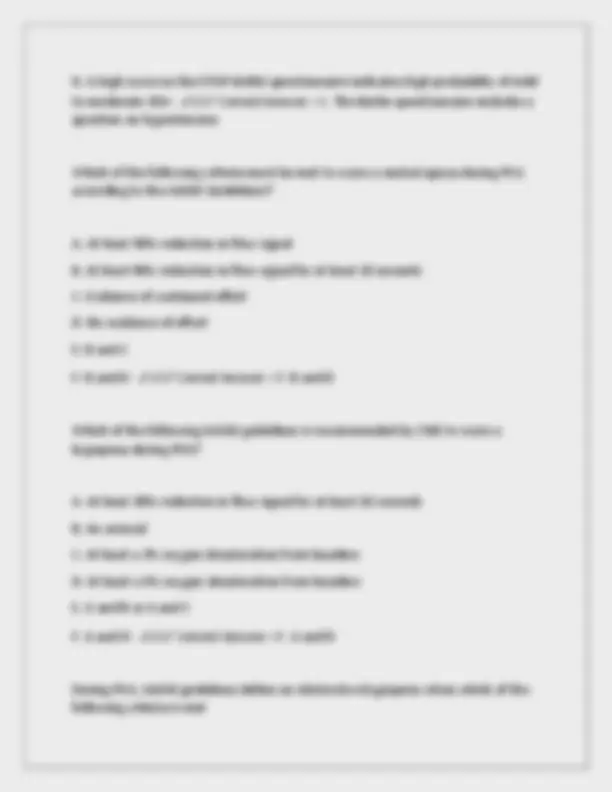
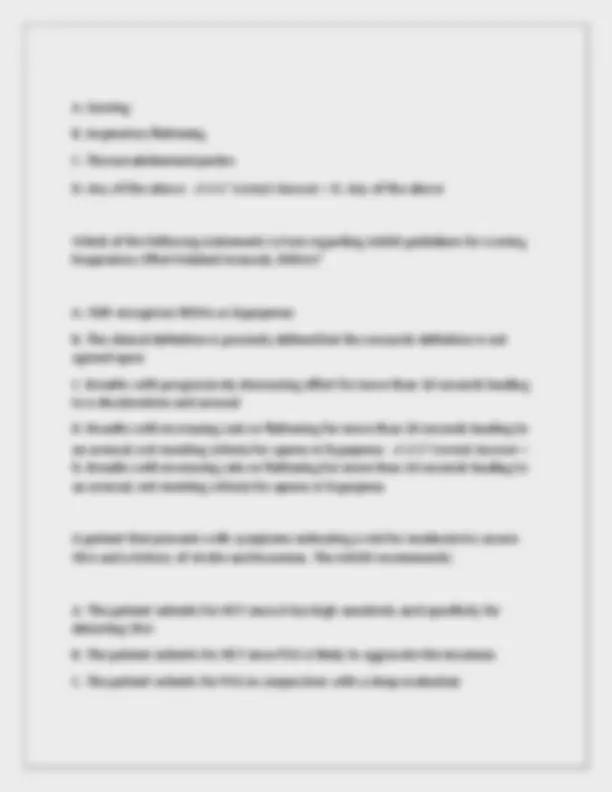
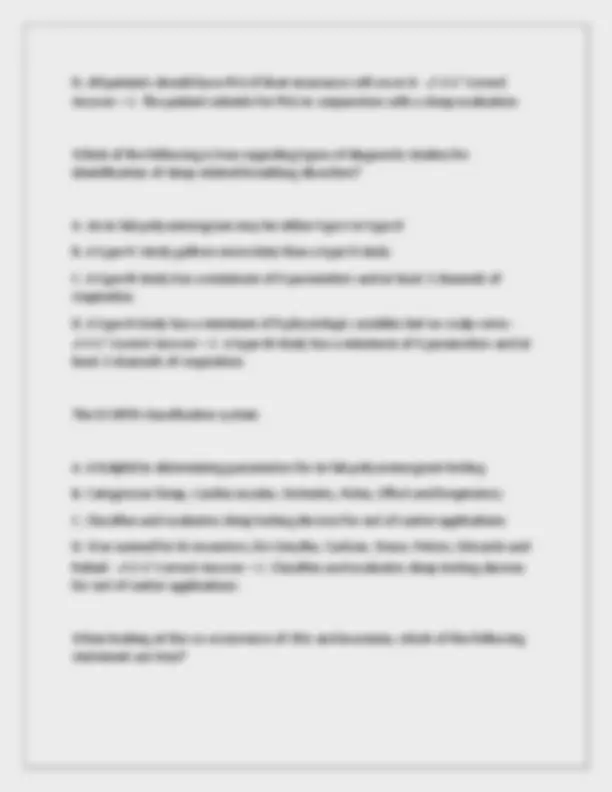
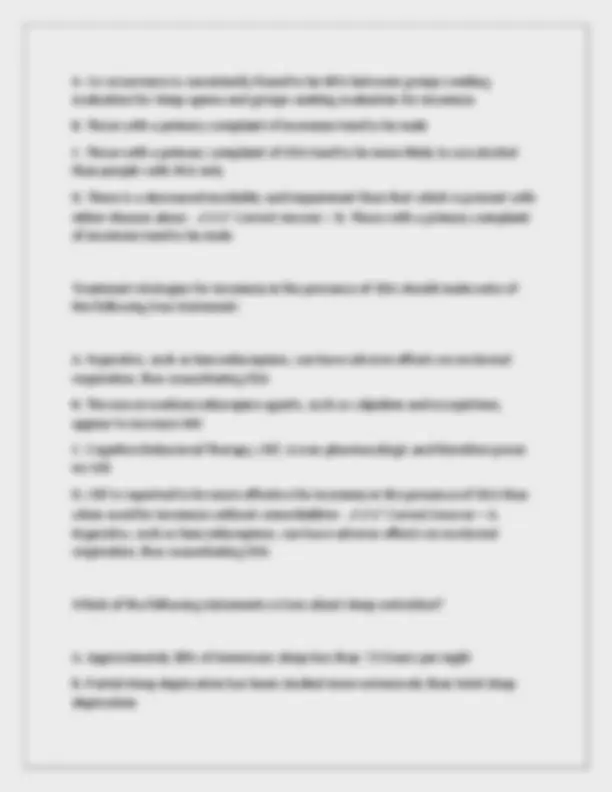
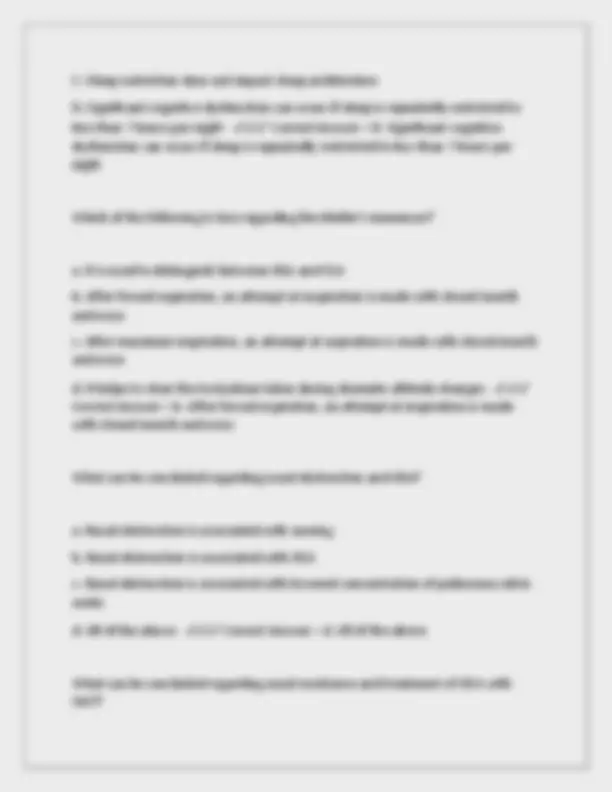
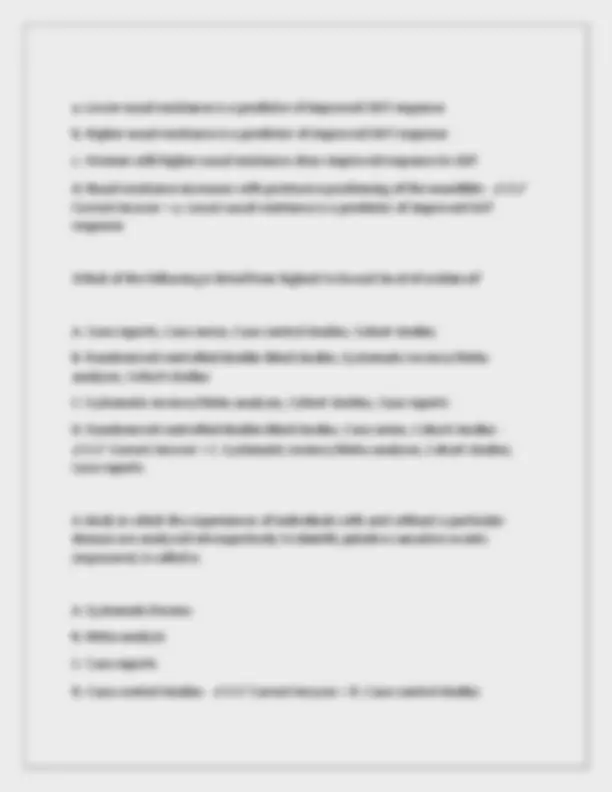
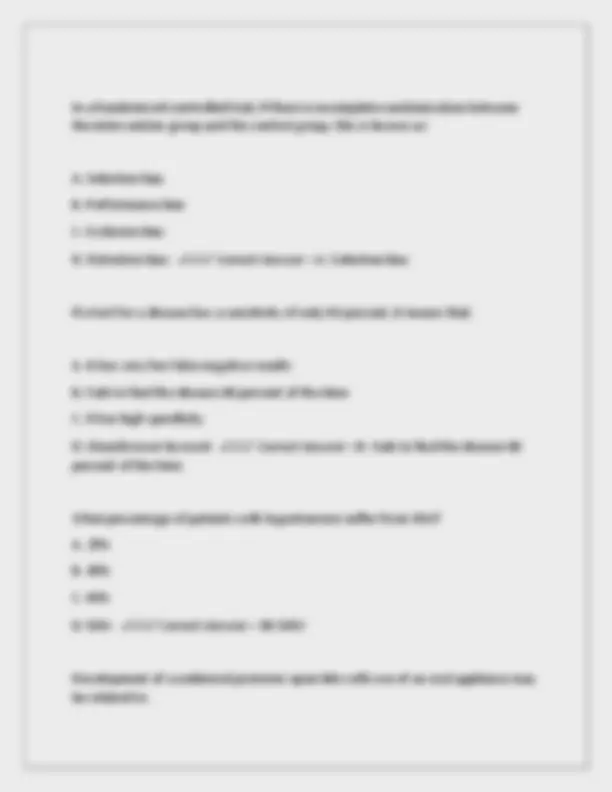
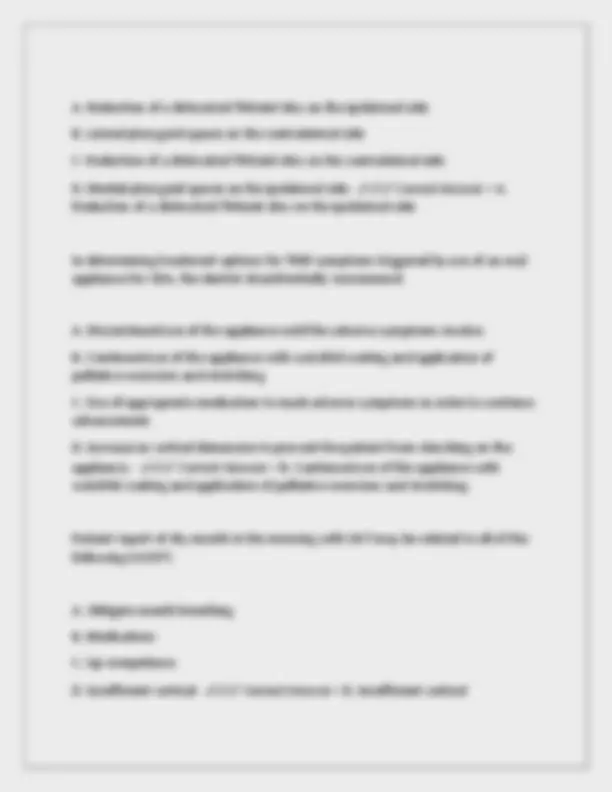
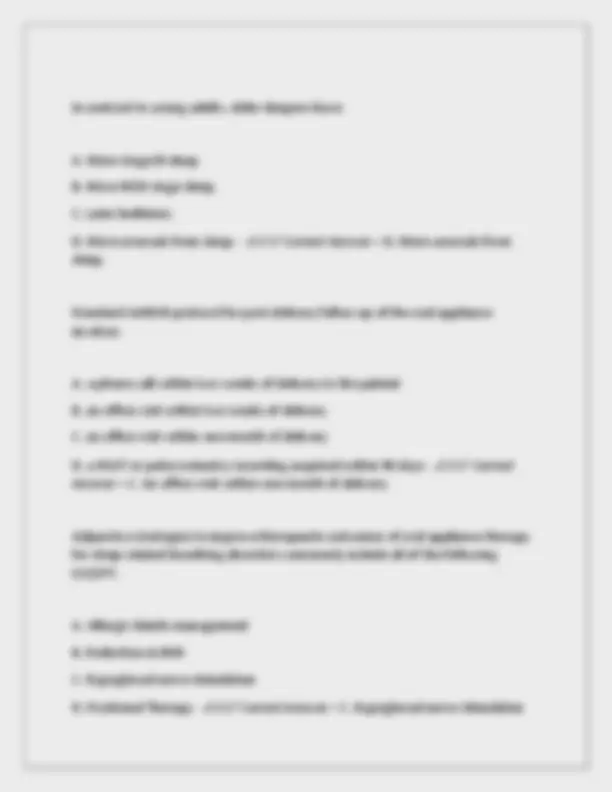
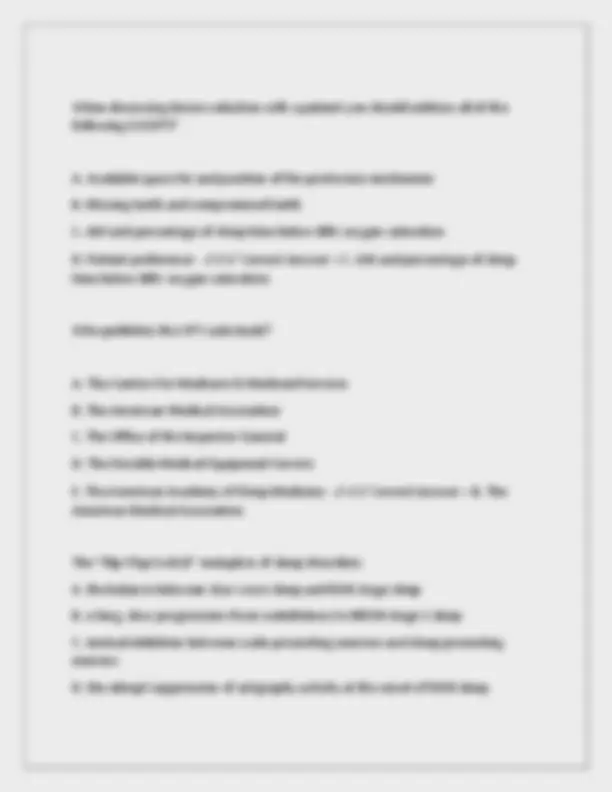
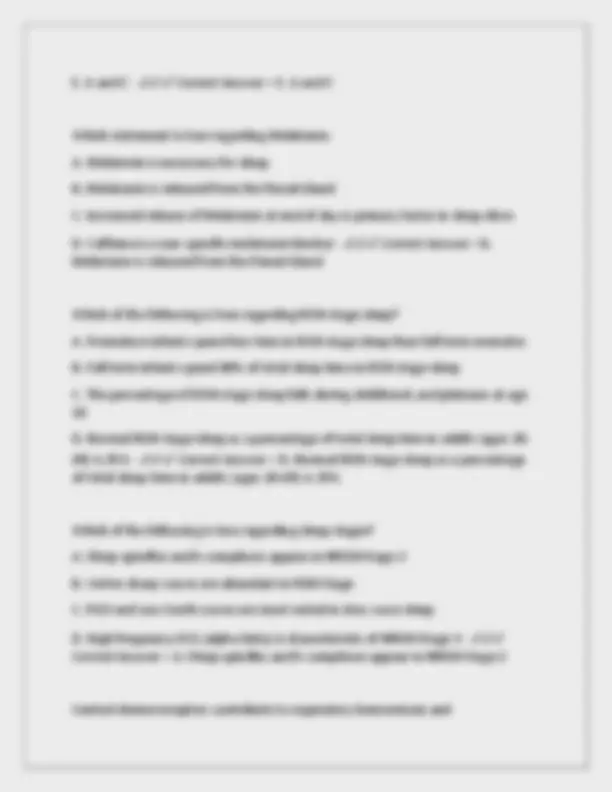
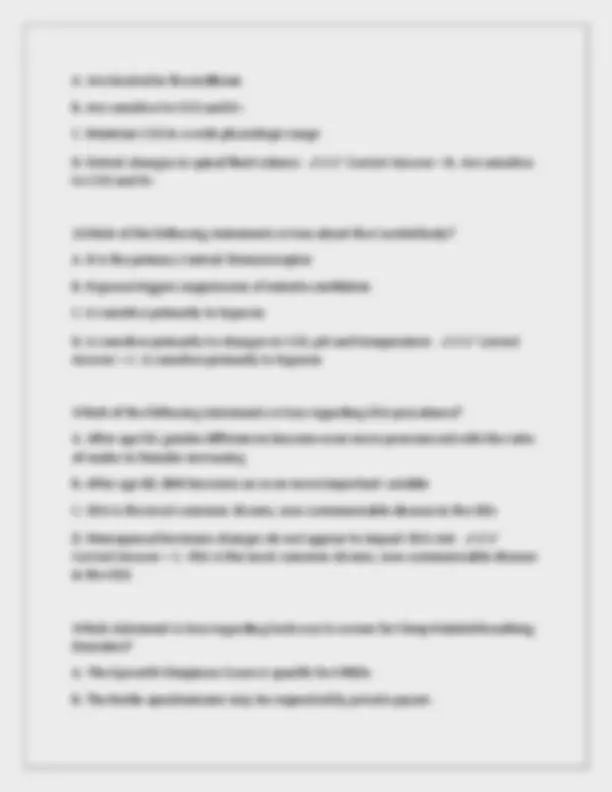
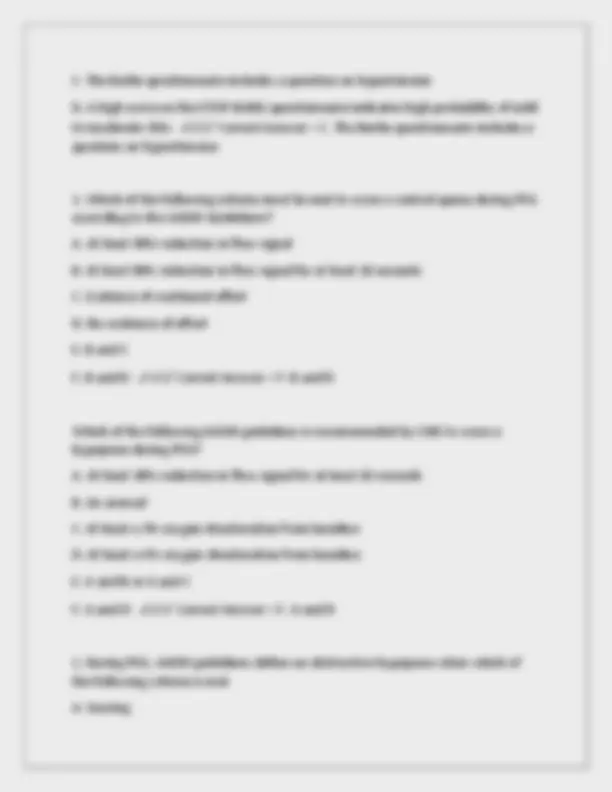
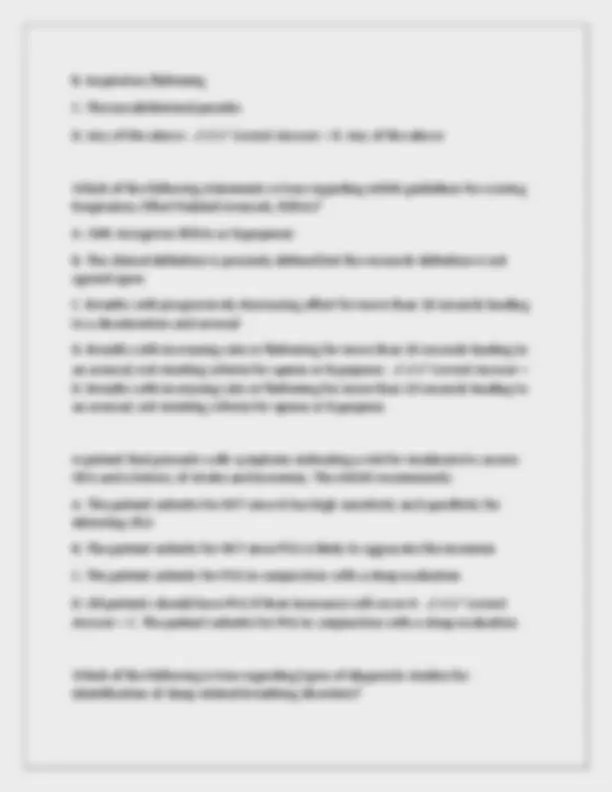
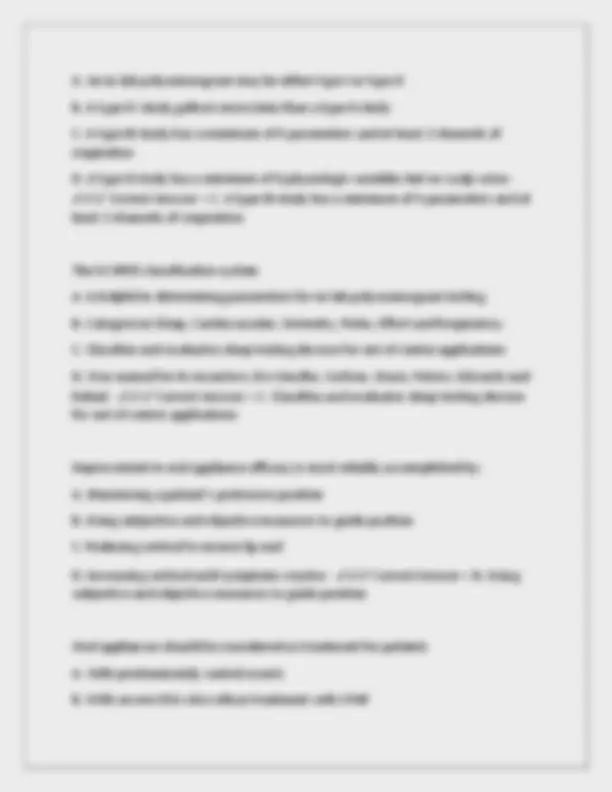
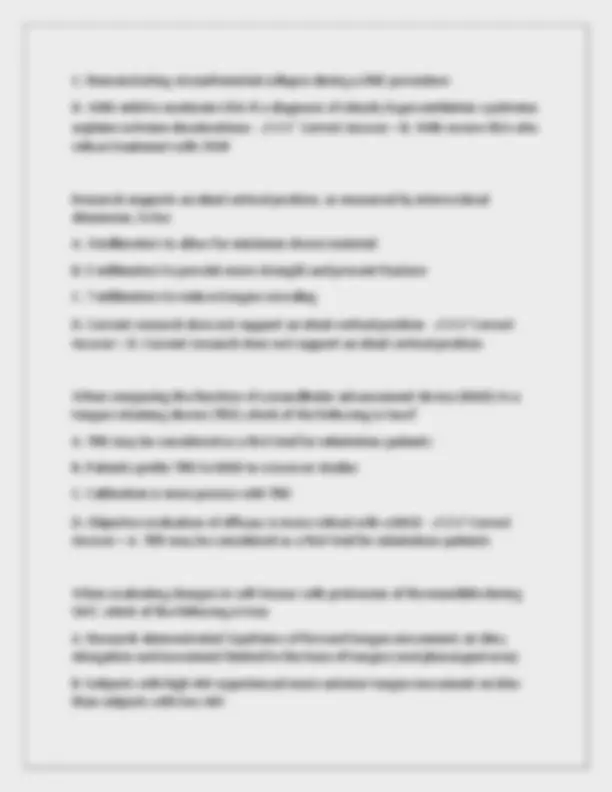
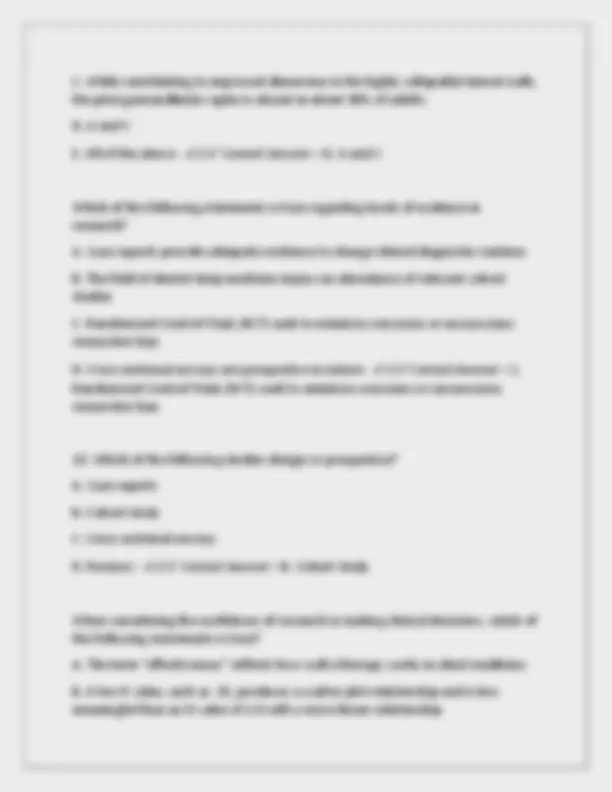
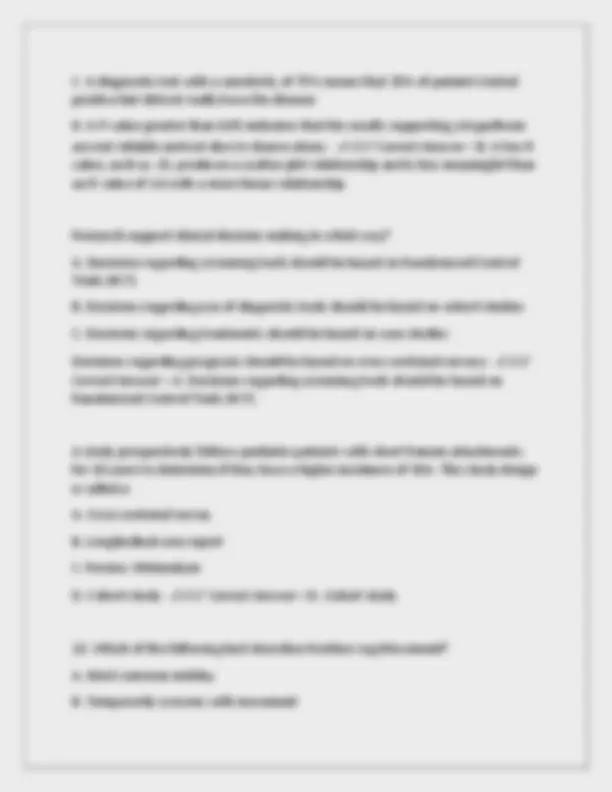
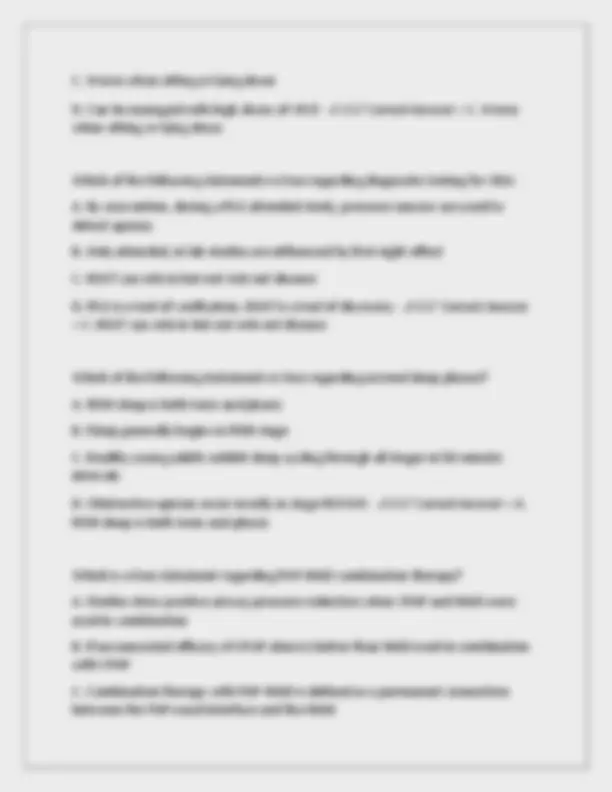
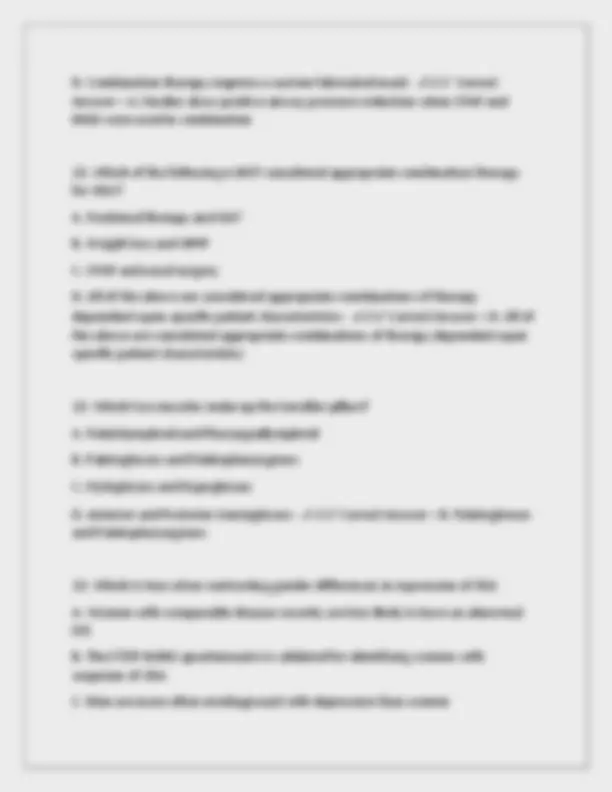
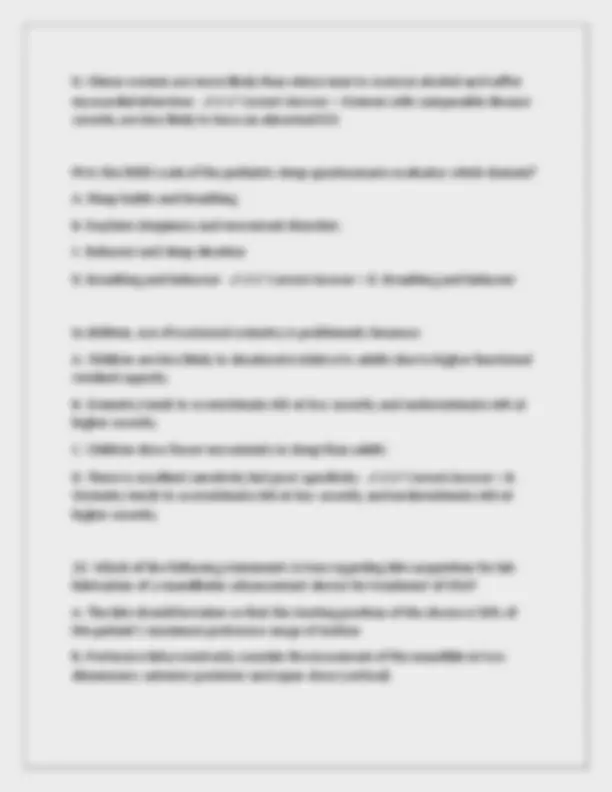
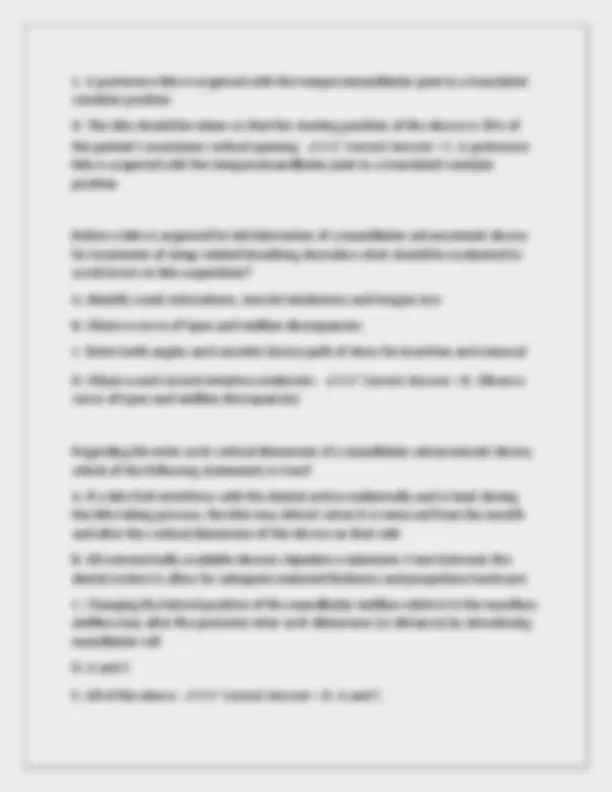


Study with the several resources on Docsity

Earn points by helping other students or get them with a premium plan


Prepare for your exams
Study with the several resources on Docsity

Earn points to download
Earn points by helping other students or get them with a premium plan
Community
Ask the community for help and clear up your study doubts
Discover the best universities in your country according to Docsity users
Free resources
Download our free guides on studying techniques, anxiety management strategies, and thesis advice from Docsity tutors
Which of the following statements is true about the Carotid Body? A. It is the primary Central Chemoreceptor B. Hypoxia triggers suppression of minute ventilation C. Is sensitive primarily to hypoxia D. Is sensitive primarily to changes in CO2, pH and temperature - ✔✔✔ Correct Answer > C. Is sensitive primarily to hypoxia What can be said regarding the standard of care for oral appliance titration or calibration procedures? A. There is no standard titration procedure B. Dentists or their supervised staff should titrate the devices for patients during clinic visits C. Titration or calibration should proceed protrusively to the patient's maximum comfortable position D. Titration or calibration should be routinely evaluated with home sleep testing - ✔✔✔ Correct Answer > A. There is no standard titration procedure
Typology: Exams
1 / 116

This page cannot be seen from the preview
Don't miss anything!





























































































Which of the following statements is true about the Carotid Body? A. It is the primary Central Chemoreceptor B. Hypoxia triggers suppression of minute ventilation C. Is sensitive primarily to hypoxia D. Is sensitive primarily to changes in CO2, pH and temperature - ✔✔✔ Correct Answer > C. Is sensitive primarily to hypoxia What can be said regarding the standard of care for oral appliance titration or calibration procedures? A. There is no standard titration procedure B. Dentists or their supervised staff should titrate the devices for patients during clinic visits C. Titration or calibration should proceed protrusively to the patient's maximum comfortable position D. Titration or calibration should be routinely evaluated with home sleep testing - ✔✔✔ Correct Answer > A. There is no standard titration procedure
An obese patient with severe OSA and chronic nasal allergies should be advised to follow which of the following initial treatment plans? A. CPAP trial B. OAT and weight loss measures C. Allergy treatments and ENT consultation D. Evaluation for HGNS - ✔✔✔ Correct Answer > A. CPAP trial What can be said regarding response rates to UTPP surgery based on the level of obstruction? A. With obstruction at the oropharyngeal level, UPPP improved the apnea index the least B. With obstruction at the nasal valve, UPPP improved the apnea index the most C. With the obstruction at the oropharyngeal level, UPPP improved the apnea index the most D. With obstruction at the hypopharyngeal level, UPPP improved the apnea index 87% - ✔✔✔ Correct Answer > C. With the obstruction at the oropharyngeal level, UPPP improved the apnea index the most Which is one of the inclusion criteria for a Hypoglossal nerve stimulation surgery? A. AHI < B. BMI > C. Concentric collapse demonstrated with DISE
A. Mouth Breathing B. Increased muscle tone on inspiration C. Increased blood flow to the soft tissue D. Frequent bruxing - ✔✔✔ Correct Answer > B. Increased muscle tone on inspiration Key features of sleep apnea as recorded during an in-lab sleep study include marked reduction or absence of air flow, arousals from sleep, slowing of heart rate and: A. Choking or gasping for air B. Oxygen desaturation C. Flattening of the nasal pressure signal D. Flailing of the arms and legs E. Sawtooth waves in the EEG - ✔✔✔ Correct Answer > B. Oxygen Desaturation Who publishes the CPT codebook? A. The Centers for Medicare and Medicaid Services B. The American Medical Association C. The Office of the Inspector General D. The Durable Medical Equipment Service E. The American Academy of Sleep Medicine - ✔✔✔ Correct Answer > B. The American Medical Association
A 48 year old man is treated with OAT for his moderate OSA. On repeat sleep testing, his apnea-hypopnea index (AHI) has decreased to 3 events per hour, and he reports resolution of snoring and daytime sleepiness. What is the most reasonable dental-medical sleep medicine follow up regimen for this patient? A. As needed B. Every 6 months for the first year, then annually C. Monthly for the first 6 months, then every 6 months D. Every other year - ✔✔✔ Correct Answer > B. Every 6 months for the first year, then annually Which of the following would exclude oral appliance therapy as a first treatment trial for OSA? A. Xerostomia B. Edentulism C. Micrognathia D. Steep mandibular plane angle - ✔✔✔ Correct Answer > B. Edentulism Reviewing your patient's diagnostic polysomnogram, you note more than a 50% epoch consists of alpha waves. According to the current PSG scoring guidelines, the patient is in which stage of sleep? A. Stage I NREM B. Stage II NREM
The 2015 Practice Guidelines created through cooperative effort of the AASM and AADSM suggest a physician should seek collaboration with a qualified dentist, described as someone who has at least: A. Board certification B. Facility accreditation C. Completion of a 1 yr residency in dental sleep medicine D. Additional training or experience in dental sleep medicine - ✔✔✔ Correct Answer > D. Additional training or experience in dental sleep medicine An understanding of loop gain is important to the clinical practice of dental sleep medicine because: A. It excludes the possibility of cheyne stokes breathing in patients with severe OSA B. It is the basis of the Mallampati classification system C. It defines the number of sequential obstructive apneas in an epoch D. It contributes to the multifactorial nature of sleep related breathing disorders - ✔✔✔ Correct Answer > D. It contributes to the multifactorial nature of sleep related breathing disorders With regards to biomechanical properties of the upper airway, which statement is true? A. Sleep apnea patients paralyzed during general anesthesia (neural drive removed) demonstrated airway compliance similar to healthy subjects B. Sleep apnea patients had more negative closing pressures
C. Sleep apnea patients demonstrate a more positive Pcrit D. There is no correlation between collapsibility when awake and collapsibility when asleep - ✔✔✔ Correct Answer > C. Sleep apnea patients demonstrate a more positive Pcrit Tagged MRI recently showed 3 patterns of tissue formation during mandibular advancement. Which of these was NOT observed? A. The whole tongue moved forward "en bloc" B. Only the superior posterior portion of the tongue moved forward C. The posterior tongue did not move, but the whole tongue elongated D. Only the inferior posterior portion of the tongue moved forward - ✔✔✔ Correct Answer > B. Only the superior posterior portion of the tongue moved forward In Van Heasendonck's 2015 systematic review of oral appliance health benefits, mean disease alleviation was calculated using the following: A. An embedded microsensor B. A highly compliant patient population C. Patient's diaries of hours of nightly device use D. Patient's attestations to hours of nightly device use - ✔✔✔ Correct Answer > A. An embedded microsensor Caffeine promotes wakefulness by suppressing or blocking:
drug or procedure being investigated and a control group receives nothing. Members of each group are prevented from knowing whether they are receiving active therapy. This would be called a: A. Randomized control trial B. Cohort study C. Randomized case report D. Blinded triple trial - ✔✔✔ Correct Answer > A. Randomized control trial The masseter muscle originates at: A. The temporal fossa B. The zygomatic arch C. The mylohyoid ridge D. The coronoid process - ✔✔✔ Correct Answer > B. The zygomatic arch In Sheats et. al., a morning occlusal guide is a common side effect management modality. Which of the following is CORRECT? A. A MOG encompasses many custom made appliances and pre-fabricated devices used in an effort to reposition the mandible into its habitual pre- treatment position B. A MOG has a very specific design as established by the AADSM consensus committee on side effects C. A morning occlusal guide was shown to stretch the lateral pterygoid muscle to full functional length with EMG studies
D. Use of an MOG assures the patient that there will be no bite changes as a result of use of an oral appliance - ✔✔✔ Correct Answer > A. A MOG encompasses many custom made appliances and pre-fabricated devices used in an effort to reposition the mandible into its habitual pre-treatment position All of the following exacerbate sleep disordered breathing, EXCEPT: A. Use of stimulants within 1 hr of bedtime B. Consumption of a heavy meal within 1 hr of bedtime C. Use of melatonin within 1 hr of sleep onset D. Use of alcohol, especially as a means to induce sleep - ✔✔✔ Correct Answer > C. Use of melatonin within 1 hr of sleep onset A patient presents to consult with you regarding oral appliance therapy for their moderate OSA. They report intermittent "jaw pain" for the past 6 weeks. You should explain that: A. It is best to postpone treatment until the pain has resolved B. An oral appliance is contraindicated for a patient that has active TMD C. A comprehensive oral-facial evaluation is necessary to ID the source of their jaw pain before considering or proceeding with oral appliance therapy D. An oral appliance will improve their jaw pain if the source of the pain is muscular, and not originating from the TMJ - ✔✔✔ Correct Answer > C. A comprehensive oral-facial evaluation is necessary to ID the source of their jaw pain before considering or proceeding with oral appliance therapy The most recent research points to the primary etiology of sleep bruxism as:
In sleep, body temperature... - ✔✔✔ Correct Answer > Decreases, then begins to rise just before morning wakeup time Which neurons are sleep promoting? - ✔✔✔ Correct Answer > - Ventrolateral Preoptic System (VLPO)
Is melatonin necessary for sleep? - ✔✔✔ Correct Answer > No, but helps synchronize circadian rhythms What causes sleep drive to buildup throughout the day? - ✔✔✔ Correct Answer > Buildup of adenosine Induces sleep by inhibiting wake promoting neurons What neurotransmitter does caffeine inhibit? - ✔✔✔ Correct Answer > Adenosine Promotes wakefulness What are some characteristics of REM? - ✔✔✔ Correct Answer > - Increased brain wave activity
What waves are associated with N1 sleep? - ✔✔✔ Correct Answer > Vertex sharp waves - alpha waves What sleep study architecture is associated with N2 sleep? - ✔✔✔ Correct Answer > - K complexes
What does the glymphatic system do? - ✔✔✔ Correct Answer > Flushes out toxins, proteins, metabolic waste from the brain How is the sleep cycle in a newborn different? - ✔✔✔ Correct Answer > - Enter REM before NREM
At least a 3% oxygen desaturation OR an arousal (CMS says 4%) Shallow breathing Decreased minute ventilation Why do humans have sleep apnea and others do not? - ✔✔✔ Correct Answer > Longer, more collapsible airway. No overlap of epiglottis and soft palate Allows advanced speech but unprotected airway during sleep What is the measure of airway patency? - ✔✔✔ Correct Answer > Pcrit Determined by sum of structural and neuromuscular determinants of airway collapsibility What does more negative Pcrit mean? - ✔✔✔ Correct Answer > Airway is open Pcrit<-10 in normal subjects What are the 2 fundamental sleep induced changes in OSA? - ✔✔✔ Correct Answer > - Changes in passive mechanics of upper airway
Where does the obstruction most often occur in OSA? - ✔✔✔ Correct Answer > Soft palate (81%) Where else can the obstruction occur in OSA? - ✔✔✔ Correct Answer > - Tongue base (46.6%)